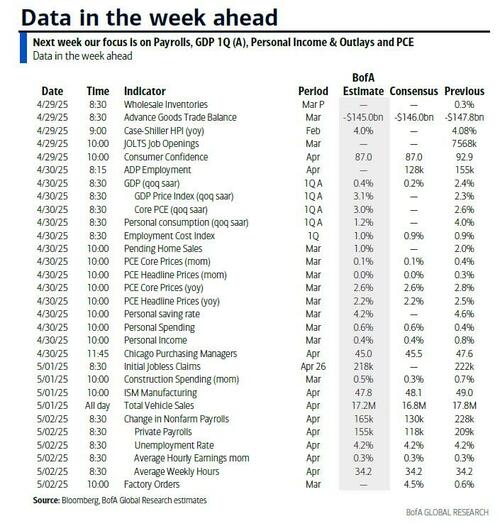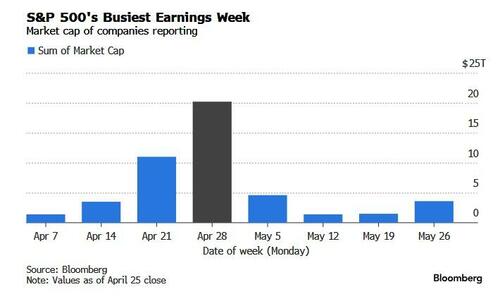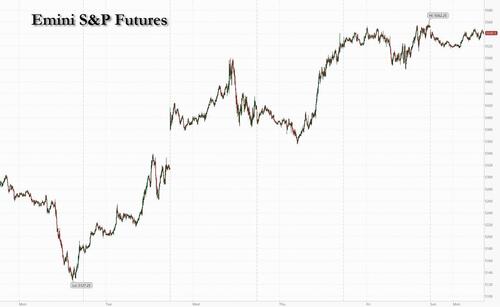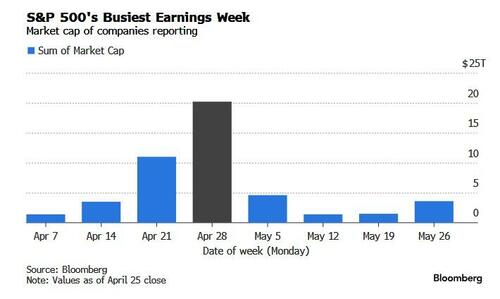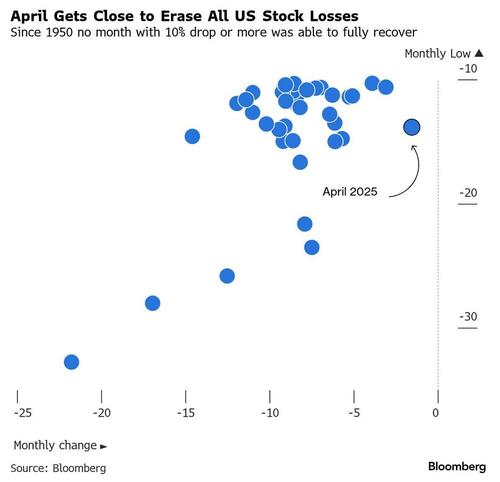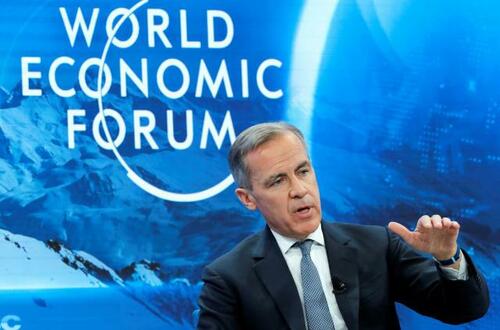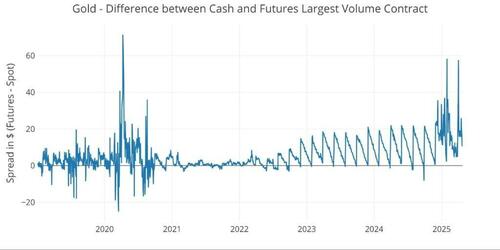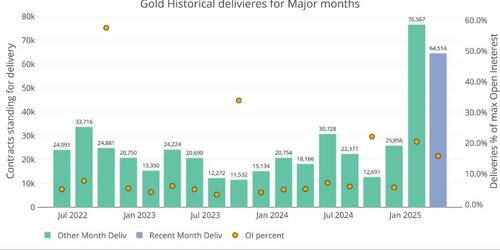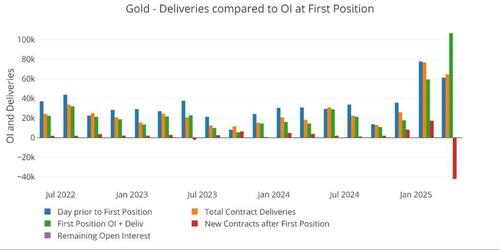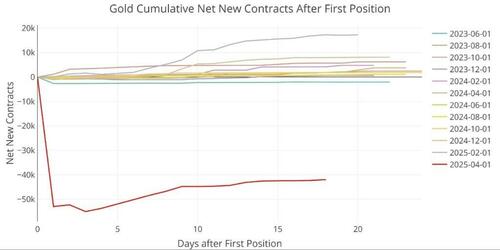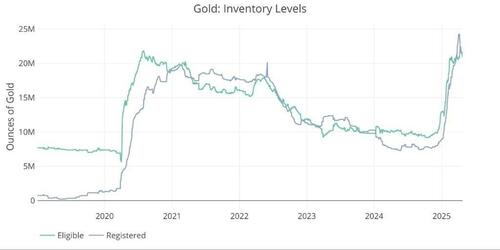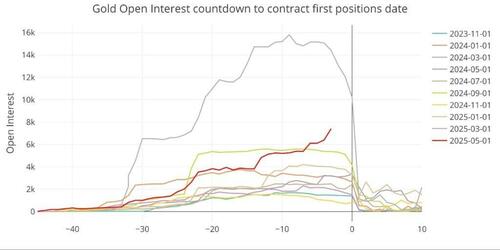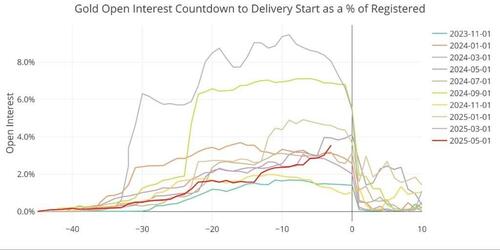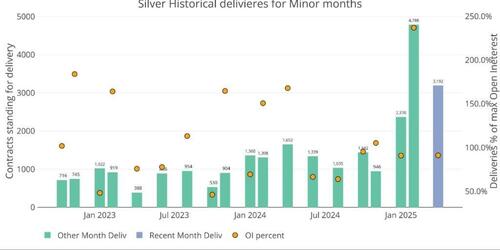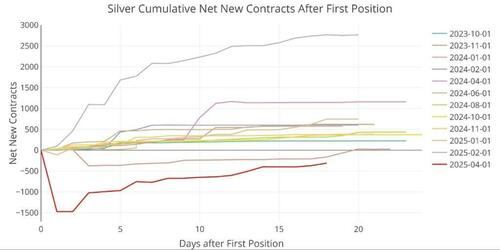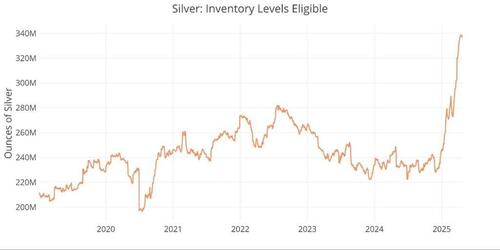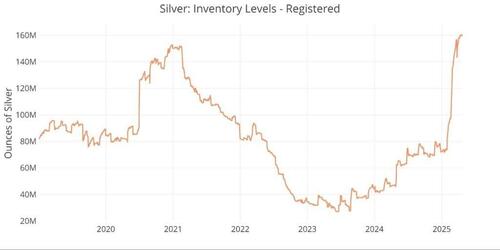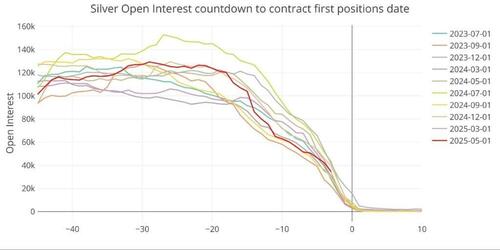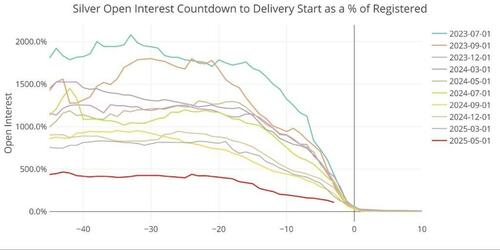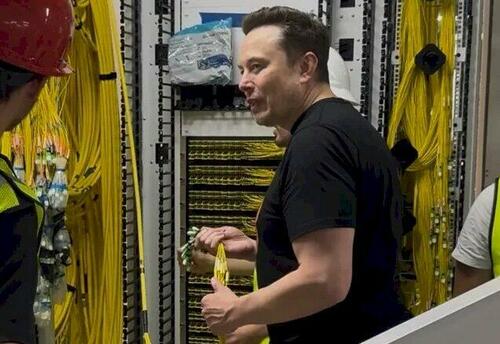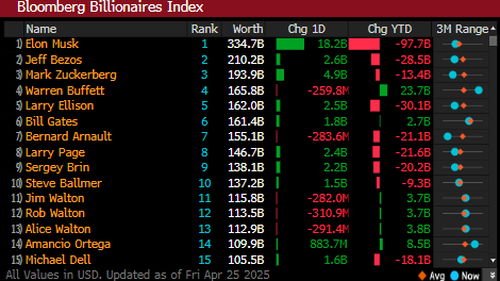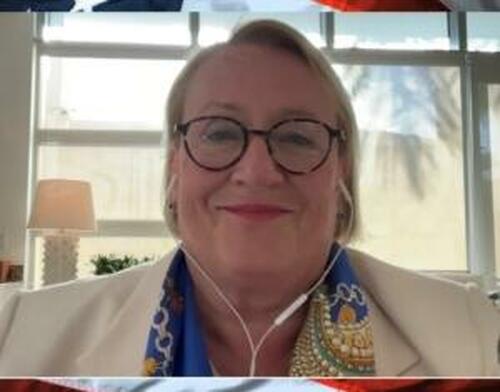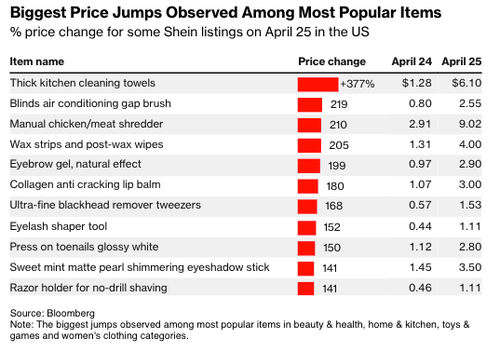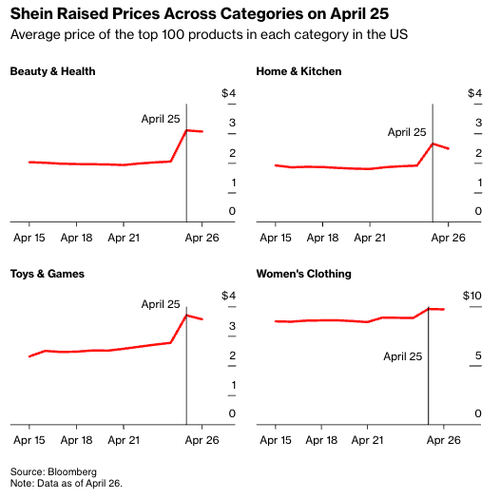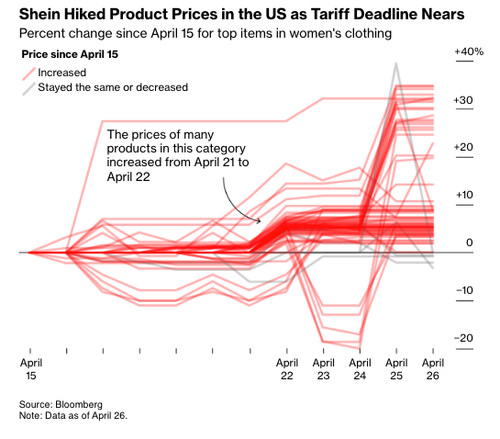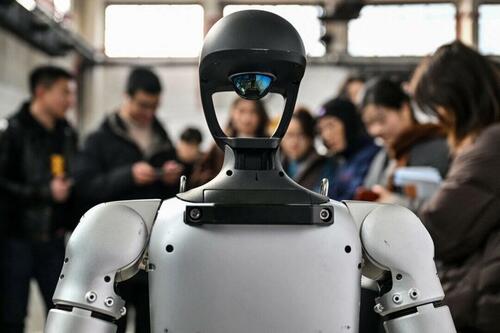In the name of tolerance, tolerance is being abolished; this is a real threat we face.
Distinction Matter - Subscribed Feeds
-
Site: Zero HedgeKey Events This Week: Peak Earnings Season, Canada Election, Payrolls, PCE, GDP... And Trade War Goes OnTyler Durden Mon, 04/28/2025 - 09:55
This week will be the first for a while where data and earnings will compete with tariff headlines as it’s a bumper week on this front. According to DB"s Jim Reid, in terms of data the main highlights in the US are payrolls (Friday), core PCE inflation and US GDP (Wednesday), ISM manufacturing (Thursday) and the latest JOLTS and consumer confidence tomorrow.
In Europe flash CPI numbers get released from Spain tomorrow, Germany, France and Italy on Wednesday, with the Eurozone aggregate on Friday (our economists’ preview is here). On Wednesday, Q1 GDP reports are due for Germany, France, Italy and the Eurozone. In Asia, the focus will be on the BoJ meeting (Thursday - our preview here) and April PMIs in China (Wednesday).
Besides the macro, we get an avalanche of micro as we face the busiest week of Q1 earnings season with corporate reporting centering around results from Microsoft and Meta on Wednesday and Apple and Amazon on Thursday. This will contribute to a whopping 40% of S&P 500 market cap reporting this week.
It's fair to say that Mag-7 earnings will go a long way to dictating the tone of the week, and perhaps quarter, now that the worst of tariffs appears to be behind us. As Jim Reid mentioned last week, remember that before Liberation Day the main theme bubbling in the background was the Mag-7 underperforming due to DeepSeek, worries about extreme levels of Capex needed to power AI forward, valuations and a disappointing Q4 reporting season around the end of January. Three months on we'll see what earnings look like.
Elsewhere we see the federal election in Canada today. Remember the ruling Liberal Party were frequently 25% behind in the polls in early-mid January even after Trudeau had announced his resignation as leader. However after the "51st state" rhetoric and aggressive tariffs, the rally round the flag movement has propelled the Liberals into a 3-4pp lead in current poll of polls which if replicated today would likely give them a small majority. So a remarkable turnaround.
Elsewhere in politics, Wednesday will mark President Trump’s first 100 days in office. So expect lots of reflections on this landmark. The UK holds local elections on Thursday with the main point of interest being how well the populist Reform Party does given they have recently edged ahead of the ruling Labour Party in national polls.
So its fair to say it will be a busy week.
Let's go into more detail on some of the main data points. Firstly, in terms of payrolls, DB economists forecast that headline (+125k forecast vs. +228k previously) and private (+125k vs. +209k) payrolls will mean revert after a strong March, particularly within the leisure/hospitality and retail sectors. The bank's econ team point out that March and April can get whipped around due to the timing of Easter and school spring breaks. Unemployment should remain steady at 4.2% though.
Wednesday's advance Q1 GDP will be interesting as the consensus suggests only +0.4% annualized growth in the quarter (+1.1% expected at DB vs. +2.4% in Q4) so that will raise some concerns if it materializes. At the same time DB sees March personal income (+0.5% DB vs. +0.4% last month) and spending (+0.6% DB vs. +0.4%) data. This will also contain the latest reading on the core PCE deflator (+0.1% vs. +0.4%) which is expected to be on the softer side this month. This will be welcome but remember this is all largely pre-tariffs.
The day by day week ahead is at the end as usual, including the highlights from a busy week for earnings on both sides of the Atlantic. One final thing to note is the US Treasury’s updated borrowing estimates (today) and the subsequent refunding announcement (Wednesday). This normally gets released without too much fuss but remember that in Summer 2023 (end July/early August) this quarterly announcement helped cause brief but great stress in markets due to higher than expected borrowing and more long-dated issuance. Since then the Treasury has managed the process with a view to minimising market fears but in an era of large borrowings these events are always worth keeping an eye out for.
Courtesy of DB, here is a day-by-day calendar of events
Monday April 28
- Data: US April Dallas Fed manufacturing activity, France Q1 total jobseekers
- Central banks: ECB’s Rehn and Guindos speak
- Earnings: Hitachi, Welltower, Waste Management, Cadence Design Systems, Deutsche Boerse, NXP Semiconductors, Domino's Pizza
- Auctions: US Treasury updated borrowing estimates
- Other: Canadian federal election
Tuesday April 29
- Data: US April Conference Board consumer confidence index, Dallas Fed services activity, March JOLTS report, advance goods trade balance, wholesale inventories, February FHFA house price index, Germany May GfK consumer confidence, Italy April consumer confidence index, manufacturing confidence, economic sentiment, March hourly wages, February industrial sales, Eurozone March M3, April economic, industrial, services confidence, Sweden Q1 GDP indicator
- Central banks: ECB’s March consumer expectations survey, Holzmann and Cipollone speak, BoE’s Ramsden speaks
- Earnings: Visa, Coca-Cola, Novartis, China Construction Bank, AstraZeneca, HSBC, Booking, S&P Global, Pfizer, Honeywell, Spotify, American Tower, Altria, Starbucks, Mondelez, Sherwin-Williams, UPS, BBVA, BP, Atlas Copco, Ecolab, Regeneron, PayPal, Royal Caribbean Cruises, Wal-Mart de Mexico, Universal Music Group, Hilton, Fair Isaac, adidas, GM, Corning, Kraft Heinz, CoStar, Ares
Wednesday April 30
- Data: US Q1 GDP, employment cost index, April ADP report, MNI Chicago PMI, March core PCE, personal income and spending, pending home sales, China April official PMIs, Caixin manufacturing PMI, UK April Lloyds Business Barometer, Japan March retail sales, industrial production, housing starts, Germany April CPI, retail sales, import price index, unemployment claims rate, Q1 GDP, France April CPI, March PPI, consumer spending, Q1 GDP, Italy April CPI, March PPI, Q1 GDP, Eurozone Q1 GDP, Canada February GDP, Australia Q1 CPI
- Central banks: ECB’s Muller speaks, BoE’s Lombardelli speaks
- Earnings: Microsoft, Meta, Samsung, Qualcomm, Caterpillar, TotalEnergies, Airbus, Iberdrola, Santander, UBS, KLA, Equinix, GSK, Tokyo Electron, MediaTek, Equinor, Mercedes-Benz Group, Credit Agricole, Barclays, Volkswagen, CaixaBank, Deutsche Post, Haleon, Robinhood, Societe Generale, Humana, eBay, GE HealthCare, ArcelorMittal, Evolution AB, Repsol, Norwegian Cruise Line, Albemarle, Wingstop, Etsy
- Auctions: US Treasury quarterly refunding announcement
Thursday May 1
- Data: US April ISM index, total vehicle sales, March construction spending, initial jobless claims, UK March net consumer credit, M4, Japan April consumer confidence index, Canada April manufacturing PMI
- Central banks: BoJ’s decision
- Earnings: Apple, Amazon, Eli Lilly, Mastercard, McDonald's, Linde, Amgen, Stryker, KKR, MicroStrategy, CVS Health, Airbnb, Parker-Hannifin, Lloyds Banking Group, Howmet Aerospace, Dominion Energy, Roblox, Targa Resources, Block, Hershey, Live Nation Entertainment, Kellanova, Blue Owl Capital, Estee Lauder, Reddit, Cameco, Duolingo, Twilio, Juniper Networks, Maplebear, Moderna, United States Steel, Roku, Wayfair, Harley-Davidson
- Other: UK local elections
Friday May 2
- Data: US April jobs report, March factory orders, Japan April monetary base, March jobless rate, job-to-applicant ratio, France March budget balance, Italy April manufacturing PMI, budget balance, new car registrations, March unemployment rate, Eurozone April CPI, March unemployment rate
- Central banks: ECB’s economic bulletin
- Earnings: Exxon Mobil, Chevron, Shell, Eaton, Cigna Group, Mitsubishi, Apollo, ING, NatWest, BASF, Standard Chartered, DuPont de Nemours
* * *
FInally, looking at just the US, Goldman writes that the key economic data releases this week are the Q1 advance GDP report and core PCE inflation on Wednesday and the employment report on Friday. Fed officials are not expected to comment on monetary policy this week, reflecting the blackout period ahead of the May FOMC meeting.
Monday, April 28
- There are no major economic data releases scheduled.
Tuesday, April 29
- 08:30 AM Advance goods trade balance, March (GS -$146.0bn, consensus -$143.0bn, last -$147.8bn); We forecast that the advance goods trade deficit narrowed by $1.8bn to $146.0bn in the March advance report, reflecting a $10bn decline in gold imports that was offset by a $10bn increase in imports from major Asian trading partners.
- 08:30 AM Wholesale inventories, March preliminary (consensus +0.7%, last +0.3%)
- 09:00 AM FHFA house price index, February (consensus +0.3%, last +0.2%)
- 09:00 AM S&P Case-Shiller 20-city home price index, February (GS +0.5%, consensus +0.4%, last +0.5%)
- 10:00 AM JOLTS job openings, March (GS 7,400k, consensus 7,500k, last 7,568k): We estimate that JOLTS job openings edged down to 7.4mn in March based on the signal from online job postings.
- 10:00 AM Conference Board consumer confidence, April (GS 90.0, consensus 87.0, last 92.9)
Wednesday, April 30
- 08:15 AM ADP employment change, April (GS +110k, consensus +124k, last +155k)
- 08:30 AM GDP, Q1 advance (GS -0.2%, consensus +0.4%, last +2.4%); Personal consumption, Q1 advance (GS +0.9%, consensus +1.2%, last +4.0%); Core PCE inflation, Q1 advance (GS +3.32%, consensus +3.0%, last +2.6%): We estimate that GDP fell 0.2% annualized in the advance reading for Q1, following +2.4% annualized growth in Q4. Our forecast reflects a slowdown in consumption growth (+0.9%, quarter-over-quarter annualized), a sharp increase in imports growth (+24.0% vs. -1.9% in Q4), and a decline in residential investment (-8.2% vs. +5.5% in Q4), but a pickup in business fixed investment growth (+7.3% vs. -3.0% in Q4), stronger exports growth (+6.8% vs. -0.2% in Q4), and a rebound in inventory accumulation. We estimate that the core PCE price index increased 3.32% annualized (or 2.77% year-over-year) in Q1.
- 08:30 AM Employment cost index, Q1 (GS +0.95%, consensus +0.9%, last +0.9%): We estimate the employment cost index rose by 0.95% in Q1 (quarter-over-quarter, seasonally adjusted), which would lower the year-on-year rate by two tenths to 3.6% (year-over-year, not seasonally adjusted). Our forecast reflects a sequential acceleration in wage and salary growth—reflecting the signal from the Atlanta Fed’s wage tracker—and slightly firmer ECI benefit growth—reflecting resets to start the year.
- 09:45 AM Chicago PMI, April (consensus 46.0, last 47.6)
- 10:00 AM Personal income, March (GS +0.2%, consensus +0.4%, last +0.8%); Personal spending, March (GS +0.5%, consensus +0.6%, last +0.4%); Core PCE price index, March (GS +0.08%, consensus +0.1%, last +0.4%); Core PCE price index (YoY), March (GS +2.67%, consensus +2.6%, last +2.8%); PCE price index, March (GS flat, consensus flat, last +0.3%); PCE price index (YoY), March (GS +2.32%, consensus +2.2%, last +2.5%): We estimate that personal income and personal spending increased by 0.2% and 0.5%, respectively, in March. We estimate that the core PCE price index rose by 0.08% in March, corresponding to a year-over-year rate of 2.67%. Additionally, we expect that the headline PCE price index remained unchanged from the prior month, corresponding to a year-over-year rate of 2.32%. Our forecast is consistent with a 0.15% increase in our trimmed core PCE measure (vs. 0.26% in February).
- 10:00 AM Pending home sales, March (GS +7.0%, consensus +1.0%, last +2.0%)
Thursday, May 1
- 08:30 AM Initial jobless claims, week ended April 26 (GS 225k, consensus 225k, last 222k); Continuing jobless claims, week ended April 19 (consensus 1,860k, last 1,841k)
- 09:45 AM S&P Global US manufacturing PMI, April final (consensus 50.7, last 50.7)
- 10:00 AM ISM manufacturing index, April (GS 47.5, consensus 48.0, last 49.0): We estimate the ISM manufacturing index declined by 1.5pt to 47.5 in April, reflecting softer manufacturing surveys so far for April (GS manufacturing survey tracker: -3.1pt to 47.4) and a slight headwind from residual seasonality.
- 10:00 AM Construction spending, March (GS +0.3%, consensus +0.2%, last +0.7%)
- 05:00 PM Lightweight motor vehicle sales, April (GS 17.2mn, consensus 17.1mn, last 17.8mn)
Friday, May 2
- 08:30 AM Nonfarm payroll employment, April (GS +140k, consensus +130k, last +228k); Private payroll employment, April (GS +140k, consensus +120k, last +209k); Average hourly earnings (MoM), April (GS +0.25%, consensus +0.3%, last +0.3%); Unemployment rate, April (GS 4.2%, consensus 4.2%, last 4.2%): We estimate nonfarm payrolls rose 140k in April. On the positive side, big data indicators indicated a slower but still moderate pace of job creation. On the negative side, we expect unchanged government payrolls, reflecting a 15k decline in federal government payrolls that offsets a 15k increase in state and local government payrolls. We see mixed implications from potential seasonal distortions: while April nonfarm payroll growth has typically picked up when the Easter holiday falls in late April, uncertainty is likely to disproportionately weigh on employment growth in months where gross hiring is particularly elevated, such as April. We estimate that the unemployment rate was unchanged at 4.2% on a rounded basis. We estimate average hourly earnings rose 0.25% (month-over-month, seasonally adjusted), reflecting negative calendar effects.
- 10:00 AM Factory orders, March (GS +5.0%, consensus +4.5%, last +0.6%)
Source: DB, Goldman
-
Site: Catholic Herald
SÃO PAULO – Among the social groups that have lamented Pope Francis’s death in Brazil, the Indigenous peoples seem to be especially impacted, with public pronouncements from several important leaders over the past week.
Cacique Raoni Metuktire, one of the major advocates of Indigenous rights and environmental protection in the South American country, said he and Francis were friends, but he didn’t know that the pontiff was sick.
“We talked about living in peace and about living well. Pope, wherever you are, hear me in spirit: May we grow even stronger. I’ll no longer be on this Earth for long and I want to meet you there with the Creator,” 93-year-old Raoni said in Kayapo language on a video released last week.
The Indigenous leader visited the pontiff in the Vatican in May of 2024, when he handed in a letter to Francis regarding climate change and its impacts in Brazil.
The Yanomami leader Davi Kopenawa, notorious in Brazil for his defense of the Amazon rainforest, also spoke of his pain for Francis’s death.
“In April of 2024, I went to Rome. I wanted to take his hand and feel if he was truly committed to the environment and to us all. And he was. He defended my Yanomami people and nature. My soul is mourning,” Kopenawa said.
Spanish-born missionary Luis Ventura, Secretary General of the Bishops’ Conference’s Indigenous Missionary Council (known as CIMI), said Pope Francis demonstrated unprecedented closeness to the Amerindian groups during his tenure in the Vatican.
“First of all, he showed a genuine concern with all popular struggles in Latin America, especially with the Indigenous causes. He defended on several occasions their rights, including their land rights,” he told the Catholic Herald.
Pope Francis saw them as “integral subjects, who have their own views, their own cosmogonies and cultures, and who have the right to survive in their own territories,” Ventura added.
“He always emphasised that we have much to learn with the Indigenous peoples. During the preparation for the Amazon Synod, he insisted that they should be heard, no matter if they were Catholics or not,” he said.
In documents like the post-synodal apostolic exhortation Querida Amazonia, the pontiff demonstrated that he had deeply paid attention to what the Indigenous groups had to say and even mentioned some of their remarks, Ventura said.
“When it comes to Catholic Indigenous people, he incentivized the Church to dialogue with them about other ways to understand rituals, ministries, and living the faith,” he argued.
Francis’s direct contact with Indigenous groups was strengthened in 2018, when he took part in a large meeting with Amazonian peoples in Puerto Maldonado, Peru. A two-handed road began to be built from then on, with Francis gaining unprecedented trust from several Indigenous peoples.
In 2023, for instance, the Guarani-Kaiowá people, one of the most attacked Indigenous groups in Brazil, sent a letter to him in which they denounced the terrible situation they were facing. The pope answered it with a message read by Cardinal Leonardo Steiner in Nov. of 2023, in which Francis declared his closeness to the Guarani-Kaiowá and his wish that his clamor for their defense could be heard by the Brazilian authorities.
The way the encyclical Laudato si’ was written, Ventura added, was accessible for Indigenous activists, reaffirming the idea that a real dialogue was going on.
“I think the fact that he was from Latin America and was part of the Latin American Church – which has been following a path over the past decades towards the poor and the excluded – were fundamental for his stance regarding the Indigenous peoples,” Ventura said, emphasising that he was courageous enough to visit Canada and apologise for the crimes of the Catholic schools against First Nations children over 150 years.
Sister Laura Manso, a nun of Indigenous origin who has been working with the Karipuna people for decades, defined Pope Francis’s stance on the Indigenous groups’ struggle as “prophetic”.
“He was very well informed about the grave threats the Indigenous groups have been facing and would always denounce such situations of death with words of hope. He chose to live side by side with the last ones in society and raised his voice to defend the Amazon and our common home,” Manso, who is also a member of the Amazonian Ecclesial Conference, told the Catholic Herald.
That’s why many Indigenous activists who are not Catholics had great admiration for the pope and now are mourning his death.
“He was concerned with our cause and was deeply humane, he respected our culture. He was not only trying to convert us to Catholicism, like many religious leaders did in the past. He knew we have our own creeds and spirituality,” Indigenous leader Eronilde Fermin, a member of the Kambeba people, told the Catholic Herald.
Fermin said she loved how Francis would defend minority groups all over the globe, not only Indigenous peoples.
“We felt the presence of God – our culture’s God and his culture’s God – with him. We loved his humbleness and his strength to fight for us. We’ll really miss him,” she said.
(Photo by Peter Summers/Getty Images)

The post Brazil’s Indigenous peoples mourn Pope Francis: ‘a prophet who stood with first appeared on Catholic Herald.
The post Brazil’s Indigenous peoples mourn Pope Francis: ‘a prophet who stood with appeared first on Catholic Herald.
-
Site: LifeNews
A new report has exposed widespread violations of informed consent laws by abortion facilities across the United States, providing another indication that abortion is the big business of selling babies – not health care.
The findings, detailed in a comprehensive study by Americans United for Life (AUL), highlight failures by dozens of clinics, including Planned Parenthood, to provide women with critical information before performing abortions.
The AUL report, titled “Unsafe,” reviewed over 25,000 pages of public documents, including 1,200 inspection reports from 39 states, spanning 2008 to 2020. It found that at least 86 abortion facilities in 21 states were cited for failing to adhere to informed consent requirements. These violations included not obtaining consent at the required time, neglecting to involve appropriately licensed staff, and failing to provide patients with contact information for complaint hotlines or visible license information.
Click here to sign up for pro-life news alerts from LifeNews.com
Among the cited facilities, 27 Planned Parenthood clinics were flagged for non-compliance.
A notable case in Missouri involved a woman who underwent a botched surgical abortion at a Planned Parenthood in St. Louis in 2019. After a five-week gap, she returned for a second abortion but was not provided with updated informed consent, despite increased risks due to the pregnancy’s progression, according to a Missouri Department of Health report.
The AUL findings also point to broader safety concerns, documenting over 2,400 health and safety deficiencies at more than 300 abortion facilities in 39 states. These include serious violations such as failure to monitor patients’ vital signs during abortions and inadequate handling of emergency situations, some requiring hospital transfers.
Pro-life advocates argue that these revelations underscore the need for stricter oversight of abortion clinics in states where killing babies is still legal.
The report has sparked calls for legislative action. AUL’s model legislation, the Women’s Right to Know Act, has been adopted in some form by 28 states as of 2020. The act mandates that physicians provide detailed information about abortion procedures, risks, and alternatives, and requires states to develop informational materials for patients.
Critics of the abortion industry, including South Dakota Gov. Kristi Noem and Louisiana Rep. Steve Scalise, have endorsed the AUL’s efforts.
The AUL report comes as the debate over abortion regulation intensifies following the 2022 Supreme Court decision in Dobbs v. Jackson Women’s Health Organization, which returned abortion oversight to the states. Pro-life groups hope the findings will bolster efforts to enact stronger protections for women and unborn children.
For more information, the full “Unsafe” report is available at aul.org.

The post Dozens of Abortion Businesses Caught Violating Informed Consent Laws appeared first on LifeNews.com.
-
Site: Ron Paul Institute - Featured Articles
The decade of 2000 marked the start of Ukraine becoming a de facto member of NATO. It not only participated in all of the main exercises, but it hosted many. In fact, between 2000 and 2010, Ukraine is ranked in the top six of countries that hosted a NATO or USEUCOM exercise. Ukraine and Georgia, who was ranked number seven, were not NATO members. What the hell? Two non-NATO countries hosted more NATO exercises than 22 of the member nations. This is prima facie evidence that the West, despite warnings from Russia, was intent on making Ukraine and Georgia official members of NATO.
Only two things distinguished Ukraine from NATO members — it did not have a financial obligation to contribute to NATO and it was not covered by Article 5. Other than that, Ukraine was operating as a de facto member of NATO by 2010.
Project Ukraine was not confined to military cooperation alone. US and UK intelligence organizations were actively involved in Ukraine and were coordinating operations and activities with both NATO and EUCOM. The CIA, for example, has intelligence officers assigned to NATO and USEUCOM headquarters. There job is to brief senior leaders on CIA operations and coordinate activities to ensure no wires get crossed. With the benefit of hindsight, it is now clear that during the period between 2000 and 2010, the US government, with collaboration from the UK, was working intently to split Ukraine away from Russia’s sphere of influence and capture it for the West.
Note: My chats with Nima and Judge Napolitano are posted at the end of this article.
2000
Cooperative Partner 2000:
The principal NATO-led military exercise conducted with Ukraine in 2000 was Exercise Cooperative Partner 2000. This exercise took place from 19 June to 1 July 2000 in the Black Sea and the area around Odessa, Ukraine. The exercise involved forces from NATO’s Standing Naval Force Mediterranean (STANAVFORMED) and the Standing Mine Counter-Measures Force Mediterranean (MCMFORMED), along with participants from ten NATO countries and six partner nations. Russia attended as an observer. The main objective was to train multinational forces to work together for peace support operations, enhancing interoperability and cooperation between NATO and partner countries.
Peace Shield 2000 (May–June 2000)
- Type: Command Post Exercise (CPX) + Field Training
- Participants:
- Ukraine (primary host)
- NATO/PfP: U.S., UK, Germany, Poland, Canada, and others.
- Observed by: Russia (under PfP, despite tensions over NATO-Ukraine cooperation).
- Objectives:
- Train for multinational peacekeeping operations (e.g., Kosovo-style scenarios).
- Improve C4I (Command, Control, Communications, Computers, and Intelligence) interoperability.
- Test Ukraine’s ability to integrate with NATO-standard procedures.
- Notable Elements:
Cooperative Determination 2000 (September 2000)
- Type: Maritime/Search-and-Rescue (SAR) Exercise
- Location: Odessa and Black Sea waters
- Participants:
- Naval forces: Ukraine, U.S. (USS Yorktown), Turkey, Romania, Bulgaria, Georgia.
- USEUCOM provided P-3 Orion surveillance aircraft.
- Objectives:
- Counter-piracy, SAR, and maritime interdiction operations.
- First major Black Sea exercise with Ukraine post-Cold War.
- Political Context:Russia criticized the exercise as “NATO expansionism” but participated as an observer.
- Demonstrated Ukraine’s push for Black Sea security partnerships amid rising regional tensions.
Cossack Steppe 2000 (Summer 2000)
- Type: Bilateral Field Training Exercise (FTX)
- Location: Desna Training Center (Chernihiv Oblast) & other sites
- Participants: Ukrainian Army + U.S. Army Europe (USAREUR) advisors.
- Focus:
- Peacekeeping tactics (e.g., convoy security, checkpoint operations).
- Medical evacuation (MEDEVAC) and combat engineer drills.
- Legacy:
- Part of the U.S.-Ukraine Joint Contact Team Program (JCTP), launched in 1994 to aid Ukraine’s military reform.
- Paved the way for future exercises like Rapid Trident (post-2006).
In 2000, the United States European Command (USEUCOM) executed its first Military Contact Plan with Ukraine, following the transfer of responsibility for U.S. military engagement in Ukraine from the Joint Staff to EUCOM in late 1998. The 2000 plan was developed collaboratively with the Ukrainian Ministry of Defense and included a variety of military-to-military events, such as planning meetings, medical, legal, and chaplain exchanges, and other cooperative activities. These events were designed to align with specific objectives and priorities identified by both sides.
2001
Cossack Express 2001 (April–May 2001)
- Location: Ukraine (multiple sites)
- Participants: Ukrainian forces, U.S. Army Europe (USAREUR), and NATO advisors.
- Focus: Logistics, medical training, and crisis response.
- Significance: Aimed at improving Ukraine’s ability to support international peacekeeping missions.
Sea Breeze 2001 (July 16–27, 2001)
- Location: Black Sea (near Odessa and Crimea, Ukraine)
- Participants: Ukraine, U.S. (USEUCOM/NATO), and other NATO partners.
- Focus: Maritime security, search and rescue (SAR), anti-submarine warfare (ASW), and amphibious operations.
- Significance: Part of the annual “Sea Breeze” series (started in 1997), enhancing interoperability between Ukraine and NATO.
Cooperative Determination 2001 (September 2001)
- Location: Yavoriv Training Area, Ukraine (near Lviv)
- Participants: Ukraine, U.S. (USEUCOM), and NATO allies.
- Focus: Peacekeeping operations (PKO), command post exercises (CPX), and joint maneuvers.
- Significance: Part of the Partnership for Peace (PfP) program, improving Ukraine’s readiness for multinational operations.
Clear Sky 2001 (October 2001)
- Location: Starokostiantyniv Air Base, Ukraine
- Participants: Ukrainian Air Force, U.S. Air Force (USAFE), and NATO partners.
- Focus: Air defense, search and rescue (SAR), and airspace coordination.
- Significance: Strengthened Ukraine’s air force interoperability with NATO standards.
2002
Cossack Express 2002″ (March–April 2002)
- Location: Ukraine (multiple regions)
- Participants: Ukrainian National Guard, U.S. National Guard (State Partnership Program), and other NATO advisors.
- Focus: Disaster response, counter-terrorism, and crisis management.
- Significance: Strengthened civil-military cooperation and emergency response coordination.
Cooperative Partner 2002″ (June 2002)
- Location: Yavoriv Training Area (Lviv region, Ukraine)
- Participants: Ukraine, U.S. (USEUCOM), NATO members (including Poland, Germany, Canada), and Partnership for Peace (PfP) countries.
- Focus: Peacekeeping operations (PKO), command-post exercises (CPX), joint staff coordination.
- Significance: Part of NATO’s Partnership for Peace (PfP) program, aimed at preparing Ukrainian forces for potential NATO-led peacekeeping missions.
Sea Breeze 2002 (July–August 2002)
- Location: Black Sea (near Odesa and Mykolaiv, Ukraine)
- Participants: Ukraine, U.S. (USEUCOM/NATO), and other NATO allies (including Turkey, UK, Greece, etc.)
- Focus: Maritime security, amphibious operations, search and rescue (SAR), anti-submarine warfare (ASW).
- Significance: Part of the annual “Sea Breeze” series (ongoing since 1997), enhancing interoperability between Ukraine and NATO naval forces.
Other Engagements:
- Ukraine also participated in NATO/PfP exercises such as “Cooperative Key” (a command-post exercise) and “Cooperative Nugget”, focusing on interoperability in peace support operations.
2003
In 2003, Ukraine participated in several notable military exercises with NATO and U.S. European Command (USEUCOM), reflecting its growing partnership with the Alliance and Western militaries. Some key exercises included:
Cooperative Archer 2003 (June 2003 – Lithuania)
- A NATO Partnership for Peace (PfP) exercise focused on peacekeeping operations.
- Involved Ukrainian troops training alongside NATO forces in command post and field exercises.
- Aimed at enhancing interoperability between NATO and partner nations.
Sea Breeze 2003 (July 2003 – Black Sea, Ukraine)
- A U.S.-Ukraine co-led maritime exercise under the Partnership for Peace program.
- Focused on naval interoperability, search and rescue (SAR), and anti-submarine warfare (ASW).
- Participating nations included the U.S. (USEUCOM), Ukraine, NATO allies, and other partners.
Cossack Express 2003 (September 2003 – Ukraine)
- A command post exercise (CPX) involving Ukrainian forces and NATO/PfP partners.
- Focused on crisis response and peace support operations.
- Part of Ukraine’s efforts to align its military doctrines with NATO standards.
Combined Endeavor 2003 (September-October 2003 – Germany)
- A large-scale communications and interoperability exercise led by USEUCOM.
- Ukrainian forces participated alongside NATO and partner nations to improve military data-sharing and command systems.
Clear Sky 2003 (October 2003 – Ukraine)
- A joint air defense exercise involving Ukrainian, U.S., and other NATO/PfP forces.
- Focused on airspace coordination and air-missile defense cooperation.
In March 2003, Ukraine finalized its 2003 Target Plan within the NATO-Ukraine Action Plan framework. This plan provided for intensified military cooperation, consultations, and preparation for large-scale military exercises, including international ones. These activities were part of a broader effort to align Ukraine’s military standards and procedures with those of NATO, as well as to test military equipment and armaments
in a multinational context.2004
In 2004, Ukraine participated in several significant military exercises with NATO and U.S. European Command (USEUCOM), reflecting its growing partnership with the Alliance and Western militaries following the 2002 NATO-Ukraine Action Plan. Key exercises included:
Cossack Express 2004 (Spring 2004)
- Location: Yavoriv Training Area, Lviv Oblast (Western Ukraine)
- Participants: Ukraine, U.S. Army Europe (USEUCOM), and NATO partners.
- Ukrainian Participants: 24th Mechanized Brigade (Yavoriv) – Trained with U.S. Army Europe’s 1st Infantry Division on peacekeeping logistics.
- National Guard Units – Drilled on crowd control (later relevant during the Orange Revolution protests).
- NATO Link: The Yavoriv Training Area later became the Combat Training Center for NATO partners (2015 onward).
- Focus: Peacekeeping drills, command post exercises (CPX), and logistical coordination.
- Significance: Aimed at preparing Ukrainian troops for potential contributions to NATO-led missions (e.g., Kosovo or Iraq).
Rapid Answer 2004 (June 2004)
- Location: Poland and Ukraine (joint border areas)
- Participants: Ukraine, Poland (a newly NATO-acceded member), and other Allied forces.
- Focus: Rapid deployment, crisis response, and interoperability with NATO forces.
- Significance: Demonstrated Ukraine’s role in regional security alongside NATO’s eastern flank.
Sea Breeze 2004 (July–August 2004)
- Location: Black Sea (Odessa and Crimea regions)
- Participants: Ukraine, U.S. Navy (USEUCOM), NATO allies (including Turkey, UK, France), and partner nations.
- Focus: Maritime security, anti-terrorism, search-and-rescue (SAR), and naval interoperability.
- Significance: Part of the annual “Sea Breeze” series (ongoing since 1997), enhancing Black Sea regional security cooperation.
Cooperative Determination 2004 (August 2004)
- Location: Crimea, Ukraine (Feodosia training area)
- Participants: Ukrainian Armed Forces, NATO members (including the U.S., UK, Germany, Poland, and others)
- Focus: Peacekeeping operations, interoperability with NATO standards.
- Significance: Part of the Partnership for Peace (PfP) program, emphasizing joint command structures and crisis response.
Political Fallout & Long-Term Impact
- Russian Reaction:
- Moscow accused NATO of “encroachment” and pressured Ukraine to join the Collective Security Treaty Organization (CSTO) instead.
- Domestic Divide:
- Pro-Western factions (e.g., Viktor Yushchenko’s bloc) praised the drills, while pro-Russian groups (Viktor Yanukovych’s Party of Regions) opposed them.
- 2008 NATO Summit:
- Ukraine’s 2004 exercises built momentum for its eventual Membership Action Plan (MAP) bid, though blocked by German/French hesitancy.
2005
Throughout 2005, NATO and Ukraine developed practical projects aimed at addressing Ukraine’s national security and defense needs. These included the launch of PfP trust funds to assist with the destruction of excess munitions and the retraining and resettlement of redundant military personnel . Additionally, there was the launch of a project to assist with the training of civilian personnel for Ukraine’s security and defense structures.
Cooperative Archer 2005 (June 2005)
- Location: Tbilisi, Georgia (but involved Ukrainian troops).
- Participants: Ukraine, Georgia, NATO members, and PfP nations.
- Focus: Crisis response, peacekeeping, and NATO interoperability (Ukraine contributed troops as part of PfP engagement).
Rapid Trident 2005 (July 9–22, 2005)
- Location: Yavoriv Training Area, Lviv region, Ukraine.
- Participants: Ukraine, U.S. (USEUCOM-led), NATO members, and PfP countries.
- Focus: Peace support operations, joint command post training, and enhancing interoperability with NATO standards.
- Significance: Part of the Partnership for Peace (PfP) program, helping Ukraine align with NATO procedures.
Sea Breeze 2005 (July 18–29, 2005)
- Location: Black Sea (near Odessa) and Mykolaiv regions, Ukraine.
- Participants: Ukraine, U.S. (USEUCOM/NATO), NATO allies (including Turkey, UK, France, etc.), and Partnership for Peace (PfP) countries.
- Focus: Maritime security, amphibious operations, and interoperability between NATO and Ukrainian forces.
- Details: Involved naval, air, and ground forces, with a focus on counterterrorism and peacekeeping scenarios.
Cossack Steppe 2005 (September 2005)
- Location: Ukraine (multiple training areas).
- Participants: Ukraine, U.S., and other NATO/PfP partners.
- Focus: Command and staff training, peacekeeping operations, and logistical coordination.
The first Rapid Trident exercise in Ukraine took place in 2005 at the Yavoriv training ground as part of the Partnership for Peace program, marking the beginning of this recurring multinational exercise.
2006
These exercises were part of Ukraine’s broader push for NATO integration following the Orange Revolution (2004).
Cooperative Archer 2006 (June 2006)
- Location: Tbilisi, Georgia (but involved Ukrainian troops)
- Participants: NATO members, Ukraine, Georgia, and other PfP nations.
- Focus: Command post exercise (CPX) simulating NATO-led crisis response operations.
- Details: Aimed at improving Ukraine’s compatibility with NATO standards in crisis management.
Sea Breeze 2006 (July 17–28, 2006)
- Location: Black Sea (near Odessa and Crimea, Ukraine)
- Participants: Ukraine (host), U.S. (USEUCOM/NATO), NATO allies (including Turkey, UK, France, Germany, etc.), and Partnership for Peace (PfP) nations.
- Focus: Maritime security, anti-terrorism, search and rescue (SAR), and interoperability between NATO and Ukrainian forces.
- Details: Involved naval maneuvers, amphibious operations, and air defense drills.
Rapid Trident 2006 (July 17–28, 2006)
- Location: Yavoriv Training Area, Lviv Oblast, Ukraine
- Participants: Ukraine, U.S. (USEUCOM-led), NATO members, and Partnership for Peace countries.
- Focus: Ground force interoperability, peacekeeping operations, and joint command procedures.
- Details: Part of the U.S.-led Joint Multinational Training Group-Ukraine (JMTG-U) initiative to enhance Ukrainian military readiness.
Cossack Steppe 2006 (September 2006)
- Location: Southern Ukraine
- Participants: Ukraine, U.S., and other NATO partners.
- Focus: Peacekeeping and stability operations training.
2007
In 2007, NATO and Ukraine conducted a notable command post exercise in Sevastopol and maintained a structured program of military cooperation under the NATO-Ukraine Military Work Plan and Annual Target Plan. The chiefs of defence from NATO and Ukraine met in May 2007 to assess progress under the NATO-Ukraine Military Work Plan for that year. They tasked their military representatives to begin preparations for the next cycle of cooperation, indicating ongoing planning and execution of joint activities. The NATO-Ukraine Annual Target Plan (ATP) for 2007outlined practical steps for cooperation in political, military, and security spheres, including exercises and advisory activities to improve Ukraine’s Euro-Atlantic integration . While the ATP itself is a planning document, it confirms that military exercises and collaborative activities were a significant part of the 2007 agenda.
Cooperative Archer 2007 (May 9–18, 2007)
- Location: Tbilisi, Georgia (but involved Ukrainian forces)
- Participants: Ukraine, NATO members, and PfP partners.
- Focus: Command post exercise (CPX) simulating NATO-led crisis response operations.
- Note: Though held in Georgia, Ukrainian troops participated as part of NATO interoperability training.
Cossack Steppe 2007 (June 2007)
- Location: Ukraine
- Participants: Ukraine with NATO advisors (including U.S. personnel)
- Focus: Peacekeeping and stability operations training.
Sea Breeze 2007 (July 16–27, 2007)
- Location: Black Sea (near Odessa and Mykolaiv, Ukraine)
- Participants: Ukraine, U.S. (USEUCOM), NATO allies (including Turkey, Greece, Canada, and others)
- Focus: Maritime security, anti-submarine warfare, search and rescue, and interdiction operations.
- Significance: Part of the annual U.S.-Ukraine co-hosted exercise series under the Partnership for Peace (PfP) program.
Rapid Trident 2007 (September 17–28, 2007)
- Location: Yavoriv Training Area, Lviv Oblast, Ukraine
- Participants: Ukraine, U.S. (USEUCOM), NATO members, and Partnership for Peace (PfP) countries.
- Focus: Peacekeeping operations, interoperability, and joint command post training.
- Significance: Part of the U.S.-led Joint Multinational Training Group-Ukraine (JMTG-U) initiative.
2008
The NATO-Ukraine Annual Target Plan for 2008 formalized cooperation, including joint exercises, training, and seminars . Ukraine’s participation in multinational exercises was part of its broader Euro-Atlantic integration efforts, as reaffirmed at the 2008 NATO Bucharest Summit . While Sea Breeze and Immediate Response were the most prominent multinational exercises involving Ukraine in 2008, other smaller joint training events and seminars were also conducted under the NATO-Ukraine partnership framework.
These exercises occurred amid Ukraine’s push for a NATO Membership Action Plan (MAP) at the April 2008 Bucharest Summit. While NATO declined to grant MAP due to opposition from some members (e.g., Germany and France), it affirmed Ukraine’s future membership prospects, stating it “will become a member of NATO” eventually. Russia strongly opposed these developments, escalating tensions that later influenced its 2014 annexation of Crimea.
Rapid Trident 2008
- Date: June 2008
- Location: Yavoriv Training Area, Ukraine (near Lviv)
- Participants: Ukrainian Armed Forces, U.S. Army Europe (USEUCOM), NATO member & partner nations.
- Focus: Interoperability, peacekeeping operations, and joint command procedures.
- Significance: Part of the Partnership for Peace (PfP) program, enhancing Ukraine’s ability to work with NATO forces.
Sea Breeze 2008
- Date: July 2008
- Location: Black Sea (Odessa region) & Southern Ukraine
- Participants: Ukraine, U.S. (USEUCOM/NATO), and other allied navies.
- Focus: Maritime security, anti-terrorism, and disaster response drills.
- Context: Annual U.S.-Ukraine naval exercise demonstrating NATO-Ukraine cooperation in the Black Sea.
Combined Endeavor 2008
- Date: September 2008
- Location: Grafenwöhr, Germany (communications-focused exercise)
- Participants: Ukraine joined NATO and partner nations.
- Focus: Improving military communications interoperability with NATO standards.
2009
The exercises in 2009 were central to strengthening Ukraine’s military cooperation with NATO and the U.S., laying the groundwork for deeper defense ties in subsequent years These exercises were part of Ukraine’s NATO Partnership for Peace (PfP) program, which sought closer military cooperation without full membership. Russia strongly criticized these drills, particularly Sea Breeze, as encroaching on its sphere of influence. The training laid groundwork for future cooperation, especially after Russia’s 2014 annexation of Crimea, when Ukraine intensified NATO-linked exercises.
These exercises also were part of the broader NATO-Ukraine cooperation, as outlined in the NATO-Ukraine Annual Target Plan for 2009, which emphasized joint training, equipment modernization, and increasing interoperability . USEUCOM (United States European Command) regularly supported and participated in these exercises, underscoring the U.S. commitment to European security and partnership with Ukraine.
Sea Breeze 2009
- Date: July 2009
- Location: Black Sea (near Odessa and Crimea)
- Participants: Ukraine, U.S. (USEUCOM), NATO allies (including Turkey, Greece, Canada), and partner nations.
- Focus: Maritime security, anti-piracy, amphibious operations, and interoperability between NATO and Ukrainian forces.
- Details: Involved naval ships, aircraft, and special operations forces. Russia opposed the exercise, viewing it as NATO expansionism near its borders.
Rapid Trident 2009
- Date: September 2009
- Location: Yavoriv Training Center (near Lviv, Ukraine)
- Participants: Ukraine, U.S. Army Europe (USEUCOM), NATO members (including Poland, Germany), and Partnership for Peace (PfP) countries.
- Focus: Peacekeeping operations, counterinsurgency, and joint command post training.
- Details: Part of the U.S.-led Joint Multinational Training Group-Ukraine (JMTG-U) initiative to enhance Ukrainian military interoperability with NATO.
Saber Guardian 2009″ (Part of the “Combined Endeavor” series)
- Date: Conducted periodically (Ukraine participated in related interoperability drills)
- Focus: Communications interoperability between NATO and partner nations.
- Details: Aimed at improving secure data-sharing and command structures.
2010
2010 was part of Ukraine’s pro-NATO phase under President Viktor Yanukovych, who initially continued military cooperation, despite later rejecting NATO membership (2010–2014). The Ukrainian Cabinet of Ministers approved an action plan in June 2010 for annual cooperation with NATO, which included participation in NATO-led peacekeeping missions, joint exercises, and training of Ukrainian troops within NATO structures. Ukraine participated in NATO’s Operation Active Endeavour, a counter-terrorist maritime surveillance operation in the Mediterranean Sea. Ukraine deployed ships to support this operation six times between 2007 and 2010, including in 2010. The State Partnership Program (SPP) between Ukraine and the U.S. National Guard (California) continued, including joint training events.
Rapid Trident 2010
- Date: July 2010
- Location: Yavoriv Training Area, Lviv Oblast, Ukraine
- Participants: Ukraine, NATO members (including the U.S.), and Partnership for Peace (PfP) countries.
- Focus: Joint multinational peacekeeping operations, interoperability with NATO forces.
- Significance: Part of the annual U.S.-Ukraine cooperative military training program under the Joint Multinational Training Group-Ukraine (JMTG-U).
Sea Breeze 2010
- Date: July 2010
- Location: Black Sea (near Odessa)
- Participants: Ukraine, U.S. (USEUCOM/NATO), and other allied nations.
- Focus: Maritime security, anti-piracy, search and rescue (SAR), and naval interoperability.
- Significance: A long-standing U.S.-Ukraine naval exercise, enhancing Black Sea security cooperation.
Saber Guardian/Rapid Reaction 2010
- Date: Conducted in multiple phases (summer/fall)
- Location: Ukraine and other Eastern European countries
- Participants: Ukrainian forces alongside U.S. Army Europe (USAREUR) and NATO partners.
- Focus: Rapid deployment, peace support operations, and joint command post exercises.
Reprinted with permission from Sonar21.
-
Site: LifeNews
“Have it your way” isn’t just for fast-food burgers anymore.
It’s also for babies.
Orchid, which labels itself as “the world’s most advanced whole genome screening for embryos during IVF,” was highlighted in a recent New York Times article headlined “This baby was carefully selected as an embryo.”
Orchid, writes journalist Anna Louie Sussman, “screens embryos’ DNA for hundreds of conditions” and also “offer[s] what is known as polygenic screening, which gives parents what is essentially a risk profile on each embryo’s propensity for conditions, such as heart disease.”
Click here to sign up for pro-life news alerts from LifeNews.com
When I was in elementary school, my mom started going blind. Retinitis pigmentosa. No family history. No treatments. No cure.
I got lucky. She didn’t. It led me to build @OrchidInc so my baby —and everyone else’s—gets to win the genetic lottery—avoid blindness— and hundreds of… pic.twitter.com/QPYC2FxmS7
— Noor Siddiqui (@noor_siddiqui_) April 1, 2025
Parents who opt to use Orchid get an extensive analysis of their embryos’ risk analysis for a variety of health conditions, including (but not limited to) autism, severe obesity, Alzheimer’s, inflammatory bowel disease, schizophrenia, diabetes, and breast cancer.
In a 2024 video, Orchid founder Noor Siddiqui compares the screening of two of her 16 embryos. Embryo 2 and Embryo 3, Siddiqui notes, are both “chromosomally normal.” But Embryo 3 has an elevated risk for breast cancer. Embryo 2, she adds, has an elevated risk for celiac disease.
Left unknown is whether either Embryo 2 or Embryo 3 will get a chance to grow up.
Welcome to our brave new world.
“The last thing that I would want is ‘Hey, we already today know that … this genetic disease exists, but … umm … I just didn’t bother just to see if that’s something that would affect my future child,’” Siddiqui says earnestly in the video.
“I think, basically, sex is for fun and embryo-screening is for babies,” she adds. “I think that it’s going to become insane not to screen for these things.”
Insane?
The ugliness of Orchid is that once you do embryo-screening, you already have a human being.
Don’t take my word for it. Take the word of Leah Culver, whose son Japhy was the first Orchid baby born. In the video, she shows her son, then three months old, a photo of him in his embryo stage.
“That’s you, Bud,” Culver coos to her son. “That’s you when you were like five cells. … Five days old.”
Lucky Japhy, whose genetic risks weren’t high enough to keep him mired in a frozen world forever, unable to grow and develop because of a parent’s fear that one day he might be fat or have digestive issues.
Nor is Orchid alone in this. A competitor, Genome Prediction, offers similar testing, allowing you to look at your embryos’ respective risks for diseases, such as asthma and melanoma (skin cancer).
Of course, it’s understandable that parents ideally want healthy children. No one wants to see their children suffer.
Siddiqui cites her mother’s disease of retinitis pigmentosa, which causes blindness, as inspiring her to start Orchid. No doubt her mother’s suffering was awful.
But would her mother have preferred to have remained a frozen embryo forever or have died, rather than be blind?
And should parents’ goal be to ensure their children suffer as little as possible?
Of course, parents shouldn’t seek out suffering for their children. But suffering is sometimes critical to producing certain types of great souls. That’s not a popular view in our hedonistic culture—or one that any of us easily accept. But while we should readily reject the idea of imposing suffering on anyone, we should also pause at the idea of saying life is only worth living if it’s unaccompanied by suffering.
Furthermore, it’s not like these companies can guarantee success.
Sure, parents may pick the lowest-risk embryo of the lot as the one that gets to stay alive and grow up. But that doesn’t guarantee control. That doesn’t guarantee that the child won’t lose a dear friend or loved one to a car accident or other early death. That doesn’t promise that the child will never be hurled into an era with political or violent upheaval. That doesn’t ensure the child will never be up at 3 a.m., eyes blinking, heart pounding from an unexpected nightmare and that bleak nighttime sense of despair.
Parents, too, have the ability to use these services to screen for more than health.
I highly recommend Simone and Malcolm Collins’ (@SimoneHCollins) Based Camp podcast for insights on the demographic crisis and the future from many angles.
They are extraordinarily hard-working and prolific, with an episode almost every day. 1/2 pic.twitter.com/zgKVmIBP1T
— More Births (@MoreBirths) August 13, 2024
Take Malcolm and Simone Collins, who publicly advocate for large families and have produced over 40 embryos, some of whom they have screened.
Writing of their experience, Sussman reports that Simone Collins says “[a]necdotally, the tests’ predictive power for behavioral traits—one of the metrics guiding their choice to implant the two embryos that are now their daughters—appears to be strong.”
“The Collinses said they wanted daughters who were ‘low stress,’ and lo and behold, Ms. Collins said, ‘ultimately both of our daughters are extremely chill and genial,’” Sussman adds.
How wonderful.
Isn’t that what parenthood is about, plucking the child out who best fits your preferences and discarding the rest?
Why should parenthood be something where the parents are challenged, where they are given children who stretch them with personalities that differ from their own or their own favored personalities? Why not just kick back and order some kids who seem to fit your desires for having a certain kind of parenthood experience?
It’s easy to see how this technology quickly creates a universe where children, like wedding venues and houses and cars and designer goods, are just another way for a couple to showcase their personality and preferences. That’s a stark contrast to the Judeo-Christian view of children as being given by God to parents, a blessing from above, not a lifestyle enhancement carefully selected to fit, not upend, a way of life.
Embryo screening is also a bleak way of looking at our technological future. We have made tremendous advances in medicine in the past 100 years. Who’s to say that there won’t be a cure or at least significantly better treatment for, say, breast cancer and Alzheimer’s by the time these children are old enough to potentially be affected?
We’re better than this—or should be.
All children, all embryos deserve love and a chance to grow up, regardless of their risks for irritable bowel syndrome or obesity, schizophrenia or cancer. That shouldn’t be a radical statement. But in our bleak times, it apparently isn’t an uncontroversial stance.
LifeNews.com Note: Katrina Trinko writes for The Daily Signal. Reprinted with permission from the Daily Signal.

The post Should Parents Kill Some Unborn Babies to Get the Perfect Child? appeared first on LifeNews.com.
-
Site: AsiaNews.itDespite the average age is still around 31, seniors over 65 are already 8.1 per cent of the more than 35 million Malaysians. Their share is bound to grow rapidly due to the combined effect of longer life expectancy and ageing in a society where care for the elderly is still almost entirely delegated to families.
-
Site: Zero HedgeFutures Erase Losses As Markets Brace For Earnings AvalancheTyler Durden Mon, 04/28/2025 - 08:26
US equity futures are little changed, reversing earlier losses as much as 0.5%, as global markets are broadly in the green amid a burst of positive sentiment, which even pushed JPM's recently bearish trading desk to turn tactically bullish this morning (more in a subsequent post). As of 8:00am ET, S&P and Nasdaq futures are down 0.1%, but well off session lows. Nvidia shares fell 1% in premarket after the Wall Street Journal reported China’s Huawei Technologies is getting ready to test a new and powerful artificial intelligence processor that the company hopes can replace some products made by Nvidia; other Mag7 names are mixed with Cyclicals/Semis under pressure and Defensives catching a bid. Europe's Estoxx advanced 0.5% over early London session with gains led by info tech and consumer staples; Asian stocks were also broadly higher with Japan erasing all post-Liberation day losses. US equities are focused this week on the tech sector, with Microsoft, Apple, Meta and Amazon all reporting earnings. The week also includes the April US jobs report, due Friday. Bond yields are higher as the curve bear steepens and the USD starts the session stronger. This is a data-heavy week but today’s focus is on regional Fed activity but the key’s this week are NFP, JOLTS, ISM-Mfg, and 25Q1 metrics.
In premarket trading, Nvidia shares slip after the WSJ reported that Huawei is getting ready to test an artificial intelligence processor that the Chinese tech giant hopes can replace some Nvidia products; others Mag7 stocks are Alphabet 0.06%, Meta Platforms +1%, Amazon +0.1%, Tesla +0.8%, Nvidia -1.5%, Microsoft -0.2%, Apple 0.6%. Boeing rises 1.5% as Airbus SE agreed to take over some assets and sites from Spirit AeroSystems, clearing the way for Spirit to be acquired by Boeing. Also, Bernstein upgraded Boeing to outperform, noting that the aircraft maker is now “making the progress it needed for the growth trajectory.” Eli Lilly slips 1.6% after HSBC double downgraded the stock to reduce — a sell-equivalent rating — from buy, saying the drugmaker’s risk-reward “is not attractive.” Here are some other notable premarket movers:
- CG Oncology (CGON) soars 40% after presenting data on cretostimogene grenadenorepvec monotherapy data at the American Urological Association annual meeting.
- Jack in the Box (JACK) rises 4% after Stifel upgrades to buy, saying new CEO Lance Tucker “has created a viable plan to strengthen the balance sheet.”
- Peloton Interactive (PTON) gains 6% after Truist Securities upgraded the fitness company to buy, saying the stock is finally nearing a point where the company’s improving fundamentals should support a recovery in shares.
- Revolution Medicines (RVMD) climbs 5% after presenting initial data from a Zoldonrasib study in patients with non-small cell lung cancer.
US futures posted modest moves as investors awaited reports from American companies worth $20 trillion, including four mega tech names AAPL, AMZN, MSFT and META, and watched for progress in US trade talks with Asian partners. Wild gyrations sparked by Trump’s April 2 tariff announcements have eased somewhat, but investors will be scrutinizing this week’s key company reports for the earnings impact of US trade policies. Fresh readings on the state of the American economy may support hopes of earlier-than-expected Federal Reserve interest-rate cuts.
Four of the Mag 7, Microsoft, Apple, Meta and Amazon, are due to report earnings this week. Analysts expect the group to deliver an average of 15% profit growth in 2025, a forecast that’s barely budged since the start of March despite the flareup in trade tensions. In terms of market capitalization, it’s the busiest week of the year for earnings, with S&P 500-listed companies worth $20 trillion reporting.
Investors are also watching for any signs of progress in US trade negotiations after Trump suggested another delay to his higher tariffs was unlikely. Asian economies, facing some of the highest US “reciprocal” tariffs, are leading the way over their western counterparts in talks with the administration.
“Ultimately, it seems that we’re moving towards a place where these policies start to make a little more sense,” Themistoklis Fiotakis, global head of FX strategy at Barclays Plc, told Bloomberg TV. “If this starts shaping up in a place where markets can understand it, can quantify it, then I think that things are going to normalize.”
To help manage the next steps, the Trump team has drafted a framework to handle negotiations with about 18 countries, including a template that lays out common areas of concern to guide the discussions. US Treasury Secretary Scott Bessent said the administration is working on bilateral trade deals with 17 key partners, not including China. Bessent reiterated the administration’s argument that Beijing will be forced to the negotiating table because China can’t sustain Trump’s latest tariff level of 145% on Chinese goods. Its standoff with China will likewise limit the potential benefits the US can reap from deals with Asian trading partners, according to Phoenix Kalen, global head of emerging markets research at Societe Generale SA.
“Already there has been a lot of investor sentiment and positioning for some deals to be done, especially with Japan, especially with South Korea,” Kalen told Bloomberg TV. “But the scope is going to be relatively limited and hampered. The concern especially for Asian trade partners around how China will respond to the terms will limit the extent to which they can agree to certain terms with the Trump administration.”
Meanwhile, Friday’s US non-farm payrolls figures will also turn attention to the health of the American economy. “In general I think this week’s data won’t be too bad for the economy because it really precedes the announcement of tariffs,” Kathy Jones, chief fixed income strategist at Charles Schwab & Co., told Bloomberg TV. “The inflation numbers shouldn’t be too bad. But I’ll really be watching the ISM numbers at the end of the week and of course, the jobs data where we could see some softness.”
The S&P 500’s recovery month-to-date from a 14% drop to -1.5% as of Friday’s close is one of the best rebounds since 1950. Still, the bounce has been too narrow to instill much confidence in a sustainable longer-term rally. Traders may stay cautious as gains have been largely headline and short-covering driven. Volatility is abating but remains elevated. It’s also coming up to the 100-day mark for Trump’s presidency.
In Europe, the Stoxx 600 is set to extend its winning streak to a fifth session as it climbs 0.7%, boosted by M&A news out of Italy as Mediobanca made a €6.3 billion ($7.1 billion) offer for the wealth management arm of Italian insurer Assicurazioni Generali SpA. Food & beverage, travel & leisure and bank stocks are leading gains while real estate and industrials lag. Here are some of the biggest movers on Monday:
- Deliveroo stock soars as much as 18% to 173p after the food-delivery firm said that DoorDash has made a cash takeover proposal at 180p a share, and it would be “minded to recommend such an offer” to shareholders.
- Traton shares rise as much as 5.5% after the German truckmaker posted first-quarter results, with analysts welcoming a strong order intake.
- Interpump shares rise as much as 4.1% in Milan trading after BNP Paribas Exane analysts upgraded the Italian hydraulics and pumps manufacturer, saying it is “an overlooked M&A story with positive risk/reward.”
- ITV shares drop as much as 3.8% after a report that France’s Banijay Group is working on plans for a takeover offer for the entire broadcaster or its studio arm. Analysts note reports of interested bidders are building, but a deal isn’t a certainty.
- Fraport drops as much as 4.5% after Jefferies downgrades the airport services provider to underperform from hold, saying it’s overexposed to slowing transatlantic and business traffic.
- Nagarro shares fall as much as 16%, to a record low, after the German IT services firm postponed the publication of its full-year results.
- BoneSupport falls as much as much as 6.6% after the company announced its CEO Emil Billback is stepping down after more than seven years in the role.
- Valneva shares drop as much as 20% after French regulators decided to suspend the use of its chikungunya vaccine Ixchiq for people aged 65 years and older.
Earlier in the session, Asian shares also rose as focus shifted to a slew of major earnings from the region, while signs that trade tensions may have peaked, at least for now, helped sentiment. The MSCI Asia Pacific Index rose as much as 0.8%, adding to last week’s 2.2% gain. Japanese benchmarks outperformed following a report on Toyota Motor Corp. chairman’s proposal to buy out Toyota Industries. Indian shares resumed their climb amid foreign inflows, while Chinese stocks were range-bound as officials reiterated their plan to strengthen support for employment and the economy. The flood of tariff-related headlines has slowed somewhat, and investors are turning their attention to earnings to gauge how Asian firms are prepared to tackle higher levies. The region is facing its busiest earnings week this season, with China’s biggest banks including Industrial & Commercial Bank of China Ltd. and Bank of China Ltd. set to release results.
“Broadly, we’re seeing some relief positioning as there is some refocusing on fundamentals, which I would say is tariff fatigue,” said Billy Leung, senior investment strategist at Global X ETFs in Australia. On China’s earnings, markets want to see more commentary from corporates on domestic confidence, he added.
In rates, treasuries were cheaper across the curve, with futures extending a drop into the early US session as investors digest news around US trade talks with Asian partners. US yields were cheaper by 2bp to 5bp across the curve, with intermediates underperforming slightly, flattening 5s30s spread by 2bp on the day. US 10-year yields traded around 4.27%, down 4 bps from Friday's close; European bonds also decline with bunds lagging by 1bp and gilts outperforming 1bp. Next Treasury coupon auction is scheduled for May 5.
In FX, the Bloomberg Dollar Spot Index is flat; New Zealand dollar lags G-10 peers and the pound leads gains, rising 0.3% against the greenback.
In commodities, spot gold falls $42 to around $3,278/oz. Oil prices are steady with WTI just below $63 a barrel.
In crypto, bitcoin rose 1.1% to $95,344.86; ether rose 0.9% to $1,819.53.
Looking at the US economic calendar, it's quiet - we only have the April Dallas Fed manufacturing activity at 10:30am. Fed officials are quiet due to blackout period. This week also includes JOLTS, consumer confidence, PCE, GDP, ISM manufacturing and April payrolls. Fed’s external communications blackout ahead of the May FOMC meeting started Saturday.
Market Snapshot
- S&P 500 mini -0.2%
- Nasdaq 100 mini -0.2%
- Russell 2000 mini -0.3%
- Stoxx Europe 600 +0.6%
- DAX +0.7%
- CAC 40 +0.8%
- 10-year Treasury yield +3 basis points at 4.26%
- VIX +0.7 points at 25.51
- Bloomberg Dollar Index little changed at 1226.26
- Euro -0.2% at $1.1347
- WTI crude -0.2% at $62.92/barrel
Top Overnight News
- Trump posted on Truth that “When Tariffs cut in, many people’s Income Taxes will be substantially reduced, maybe even completely eliminated. Focus will be on people making less than $200,000 a year. Also, massive numbers of jobs are already being created, with new plants and factories currently being built or planned. It will be a BONANZA FOR AMERICA!!! THE EXTERNAL REVENUE SERVICE IS HAPPENING!!!”. Trump also posted that “…this is a crucial week to work on “THE ONE, BIG, BEAUTIFUL BILL,” which will contain Massive Tax Cuts, Strong Border Security Measures, Major Military Advancements, Dramatic Deregulation, Powerful Spending Reforms, and more!”
- Trump will meet with House Speaker Johnson at 2pm ET and will be signing executive orders focused on restoring law and order and securing the homeland at 5pm ET on Monday.
- Mark Carney is seeking a fourth Liberal win in Canada in today’s election. Pierre Poilievre’s Conservatives chipped away at his lead in the final days of the campaign, but surveys still point to a probable Liberal victory. BBG
- Ukraine’s Volodymyr Zelenskiy said he’s hopeful for a lasting peace after talking with Trump, who questioned whether Vladimir Putin genuinely wants to end the war, and floated further sanctions. BBG
- Huawei is developing an AI processor that it hopes may replace some Nvidia products, the WSJ reported. BBG
- Trump’s trade war with Beijing is starting to affect the wider US economy as container port operators and air freight managers report sharp declines in goods transported from China. FT
- The drastic reduction in goods from China hasn’t been felt by many Americans yet, but that’s about to change. By the middle of May, thousands of companies — big and small — will be needing to replenish inventories. Giant retailers such as Walmart Inc. and Target Corp. told Trump in a meeting last week that shoppers are likely to see empty shelves and higher prices. BBG
- China’s top economic officials said the country could do without American farm and energy imports as they vowed to achieve a 5% GDP growth target for the year despite the trade war with the US. FT
- China has rejected US President Donald Trump’s claims that he received a phone call from Chinese leader Xi Jinping. The Trump administration has repeatedly asserted over the past week that the US president had spoken by phone with Xi and trade talks took place. SCMP
- A senior South Korean government official ruled out on Monday that Seoul would agree to a trade package with Washington by the time the country holds a presidential election on June 3, and flagged challenges to reaching a deal even before early July. RTRS
Tariffs/Trade
- Chinese President Xi and US President Trump have not had a call recently, according to China's Foreign Ministry; says the US and China have not conducted negotiations and consultations on tariffs.
- USTR’s office was reported on Friday to have prepared a framework for staggered reciprocal trade negotiations aimed at streamlining talks with 18 partners on a rolling basis over the next 2 months until the US’s July 8th deadline, according to WSJ.
- US Treasury Secretary Bessent said he had interaction with his Chinese counterpart in Washington last week and thinks the Chinese will see the tariff level as unsustainable and he also thinks there is a path to an agreement with China on tariffs, according to ABC News. It was separately reported that Bessent had met with Japanese Finance Minister Kato on Thursday and held productive discussions across a broad range of bilateral issues including reciprocal trade, while he was said to be encouraged by discussions with South Korean officials that focused on an ‘expanded equilibrium’ which encourages rather than restricts trade.
- US Agriculture Secretary said the US is holding daily conversations with China over tariffs.
- China has reportedly quietly exempted some US-made products from tariffs with Beijing said to have been canvassing companies and waiving duties on US goods in sectors where there is a lack of alternatives, according to WSJ.
- Shein is said to have raised US prices on some items by as much as 377% ahead of tariff increases, according to Bloomberg.
- Fox’s Gasparino posted on X that the Trump Administration would like to roll out trade deals this week, at least the outlines that have been agreed upon, citing sources close to the matter.” However, he also noted there are a lot of moving targets that could delay matters, while the deals on deck include India, Japan and maybe South Korea and Australia, although the White House spokesperson didn’t respond to a request for comment.
- Pershing Square CEO Ackman posted on X that the US could choose to unilaterally pause China tariffs to better facilitate US companies transitioning supply chains out of China, while he believes the US and China are incentivised to take tariffs down to more reasonable levels of 10%-20% as quickly as possible.
- South Korean's Vice Industry Minister says no chance of reaching an agreement on a trade package with the US before the June 3rd snap elections.
A more detailed look at global markets courtesy of Newsquawk
APAC stocks were mixed amid a lack of major catalysts from over the weekend and with a very quiet calendar to start a busy week of earnings results and key data releases including the latest US NFP report. ASX 200 was led higher by outperformance in tech, healthcare and energy, while miners lagged after mixed production updates. Nikkei 225 advanced at the open as participants digested earnings releases and M&A news in which Toyota Motor's chairman and founding family made a takeover proposal for Toyota Industries. However, the index has since pulled back from today's peak after failing to sustain a brief return above the 36,000 level. Hang Seng and Shanghai Comp lagged amid some disappointment from Beijing's press conference on policies and measures for stabilising employment, ensuring stable growth and promoting high-quality development which was conducted by the deputy heads of government agencies and the PBoC and lacked any major concrete policy measures. Japan's TOPIX Index erases all losses since the April 2nd US tariff announcement.
Top Asian News
- China held a press conference about policies and measures on stabilising employment, ensuring stable growth and promoting high-quality development which was attended by deputy heads of Chinese government departments and the PBoC.
- PBoC Deputy Governor said China will cut RRR and interest rates at an appropriate time, as well as guide financial institutions to guarantee financing demand for foreign trade firms. Furthermore, the PBoC is studying plans to enrich policy kits and will roll out new policies when needed, while it will boost financing support for private firms, allowing private firms to issue more debts.
- MOFCOM Vice Minister Sheng said China will further improve the second-hand car markets and will smooth consumption of used car market this year, while China will push the expansion of healthcare and childcare services and actively expand imports.
- China NDRC vice chief said will closely monitor domestic and external changes and improve policy toolkits, while they will unveil new policies based on changes in the economic situation and some new policies will be rolled out in Q2.
- China’s Finance Minister said China will adopt more proactive macroeconomic policies to promote the realisation of the growth target and that China is willing to further open up its super large markets to the world to achieve mutual benefits.
- China’s Cabinet passed the draft law of China’s medical security and will submit it to the NPC Standing Committee for deliberation, while it also approved the Sanmen nuclear power plant in Zhejiang province.
- China issued a notice on further improving tax refund policies for foreign tourists to boost inbound consumption and will promote the expansion of tax refund stores at shopping centres, scenic spots, airports and hotels.
- Chinese President Xi said China will use various policies to support development, while he urged for the healthy and orderly development of AI.
- China’s top market regulator said regarding a media report of separating the Panama Port from the CK Hutchison (1 HK) deal, that they are paying close attention to the transaction and will review it in accordance with the law. Furthermore, the regulator said parties to the transaction must not use any means to avoid a review.
- TikTok owner ByteDance plans to enter online shopping in Japan as it seeks to expand outside of the US.
- Huawei approached some Chinese tech companies about testing the technical feasibility of the new chip called Ascend 910D, according to WSJ.
- Rumours were circulating in social media that DeepSeek’s R2 AI model is nearing release which is set to feature double the parameters of R1.
- Following the Politburo statement on Friday, which flagged further interest rate cuts, a Reuters source close to the PBoC said it was in no rush to trim rates as the impact of tariffs is still unclear.
- BoJ Quarterly Schedule of Outright Purchases of JGBs: pace maintained for May.
European bourses (STOXX 600 +0.4%) opened modestly firmer across the board, and have traded rangebound throughout the morning thus far given limited fresh macro drivers. European sectors hold a strong positive bias, but with the breadth of the market fairly narrow. Food Beverage & Tobacco takes the top spot, joined closely by Autos. Real Estate sits at the foot of the pile, given the relatively higher yield environment today.
Top European News
- BoE Governor Bailey and US Treasury Secretary Bessent held discussions on financial markets and the regulatory environment.
- ECB’s Centeno said uncertainty is dominating economic analysis which was largely being caused by US trade policy.
- ECB’s Kazaks urged cautious steps and said the ECB should only lower interest rates into accommodative territory if the growth outlook continues to deteriorate much further, according to Bloomberg.
- ECB's Knot said the ECB June meeting is going to be really complicated, according to European press cited by Bloomberg.
- ECB’s Simkus said the ECB may have to cut rates a couple of more times as US tariffs weigh on economic growth and as inflation continues to slow, according to Bloomberg.
- ECB's Villeroy says he "does note see any extra inflation for Europe; says we still have margin for rate cuts in Europe".
- ECB policymakers reportedly are becoming increasingly confident about a rate cut in June although there is little to no appetite for a big move, according to six sources cited by Reuters. It was also reported that the central bank established a task force to simplify banking regulation.
- SNB adjusts the remuneration of sight deposits; lowers the threshold factor to 18 (prev. 20), effective June 1st.
FX
- A choppy session for the Dollar, but ultimately flat on spot month end in what has been the quiet before the storm in terms of news flow thus far, with the rest of the week packed with risk events including the first look at Q1 USD GDP and the US labour market report. There was minimal major and new tariff news, but US consumers may soon feel the impact (e.g. Shein raising prices by up to 377%, logistics slowdown in air freight and imports). DXY currently resides in a relatively tight 99.46-99.84 range.
- EUR is subdued, albeit marginally, against the backdrop of a string of relatively dovish ECB rhetoric, whereby policymakers are becoming increasingly confident about a rate cut in June. EUR/USD resides in a 1.1330-80 range.
- Flat trade for the JPY amidst a lack of major updates over the weekend. US Treasury Secretary Bessent met with Japanese Finance Minister Kato on Thursday and held productive discussions across a broad range of bilateral issues including reciprocal trade. USD/JPY resides in a 143.29-143.90 range.
- GBP is slightly firmer in a quiet session thus far to start the week. In terms of UK trade headlines, UK Chancellor Reeves said she met with US Treasury Secretary Bessent, says the goal is reaching an agreement that is in both their national interests. GBP/USD trades in a 1.3280-1.3346 range.
- Antipodeans are lower intraday amid the cautious risk tone alongside ongoing tariff uncertainty between the world's two largest economies, whilst domestic updates have been light. AUD/USD dipped under Friday's trough in a 0.6369-0.6406 intraday range.
Fixed Income
- USTs are contained, but do hold a downward bias. Newsflow on the tariff/trade front included indications of a potential path to a US-China agreement, however, specifics have been light with major catalysts ex-geopols a touch light. Amidst this, USTs find themselves in a thin 111-14+ to 111-22+ band. Ahead, the docket is focussed on the Dallas Fed Manufacturing Business Index before the Treasury Financing Estimates ahead of Wednesday’s Quarterly Refunding.
- Bunds are in-fitting with USTs and as such are also in a relatively modest 131.32 to 131.76 band. Developments for the bloc, ex-earnings, have been light. The slight underperformance seen in EGBs vs USTs/Gilts is likely a function of some concession into upcoming EZ supply where over EUR 5bln is expected to be sold across three lines. On the ECB front, Reuters reported that officials are increasingly confident on a June move, though there is little/no appetite for a big move.
- Gilts are essentially unchanged in a very narrow 93.10 to 93.33 band. As above, updates light as we await further details on the meeting between US Treasury Secretary Bessent and BoE Governor Bailey, a discussion on regulation and financial markets which was reported as being “good”.
Commodities
- Crude benchmarks have been trading very choppy on either side of the unchanged mark, as traders digest the latest US-Iran talks and Ukraine peace talks. On the former, talks are reportedly progressing, but there is still a lot of work to do. WTI and Brent trade at USD and 63.50 and 65.70/bbl respectively.
- Gold is softer, and underperforms within the metals space in a continuation of the sell-off from record highs, printed Tuesday at USD 3500/oz, currently, the yellow metal is trading either side of the USD 3,280/oz mark, with eyes on the USD 3300/oz mark, a level which it retreated from overnight.
- Base metals are mixed, given the flimsy risk tone and after China's press briefing on policy underwhelmed. 3M LME Copper sits in a busy USD 9,316.15-9,402.85/t range.
- China is stockpiling oil amid Trump tariff shocks impacting crude prices as imports of crude to China surged in March and continued to accelerate in April with imports at nearly 11mln BPD vs 8.9mln BPD in January, according to FT citing Kpler data.
- China Q1 gold consumption fell around 6% Y/Y to 290.5 metric tons and gold production rose 1.5% Y/Y to 87.2 metric tons, according to the China Gold Association.
Geopolitics: Middle East
- Israel's Defence Minister said Israel conducted an attack on a site in Lebanon’s capital of Beirut which stored precision missiles.
- Qatar’s PM said he saw some progress in Thursday’s Gaza talks.
- Iran’s Foreign Minister Araqchi said the next round of nuclear talks with the US could occur next Saturday with the venue to be decided by Oman, while he added that both sides are showing seriousness and determination. Furthermore, a senior US official said the third round of nuclear talks with Iran were positive and productive with progress made on getting a deal but noted there is still much to do.
- Oman’s Foreign Minister said US-Iran talks will continue with a further high-level meeting provisionally scheduled for May 3rd and core principles, objectives and technical concerns were all addressed in US-Iran talks on Saturday.
- Israeli PM Netanyahu called for the complete dismantling of Iran's nuclear programme, insisting that any deal with Tehran must also address its ballistic missile capabilities, according to AFP News Agency.
- A huge explosion at a key Iranian port killed at least 40 and injured around 800 others. It was separately reported that an Iranian Defence Ministry spokesperson said there was no military material in the port affected by the blast, while - Russia will send several planes to Iran to help extinguish the fire at Iran’s port.
Geopolitics: Ukraine
- US President Trump met with Ukrainian President Zelensky at the Vatican for 15 minutes which Zelensky’s staff said was constructive, covered a lot of ground and they agreed to meet again, while the White House said the meeting was very productive.
- US President Trump said the meeting with Ukrainian President Zelensky went well and we'll see what happens in the next days, while Trump is very disappointed with Russia and wants Russian President Putin to stop shooting and reach a deal. Furthermore, Trump said the confines of a deal are there and that Zelensky is calmer now and wants to make a deal, while it was separately reported that President Trump said he thinks Ukrainian President Zelensky is ready to give up Crimea, according to Al Arabiya.
- US President Trump said there was no reason for Russian President Putin to be shooting missiles into civilian areas, cities and towns over the last few days which makes him think that Putin doesn’t want to stop the war and is just ‘tapping’ him along, while Trump added too many people are dying and this has to be dealt with differently through banking or secondary sanctions.
- US Secretary of State Rubio said Russia and Ukraine are generally closer to a peace deal than in the last three years and a peace deal needs to happen soon, while he added that the US has options to hold responsible those that don’t want a Ukraine peace deal, according to NBC.
- Russian President Putin confirmed Russia’s readiness to negotiate with Ukraine without preconditions during a meeting with US envoy Witkoff, according to IFAX.
- Russian President Putin said Kyiv’s adventure in the Kursk region completely failed and Chief of General Staff Gerasimov said Ukrainian saboteurs in Russia’s Belgorod region have been liquidated. Furthermore, Russia’s military commander told Russian President Putin that scattered remnants of Ukrainian forces in Russia’s Kursk region will be destroyed soon, according to RIA.
- Russian Foreign Minister Lavrov said Russia will continue to target sites used by Ukraine’s military, foreign fighters and military instructors sent by Europe, while he added that Russia would be willing to store Iran’s enriched nuclear material if both the US and Iran believe that was useful.
- Ukrainian military said Moscow’s assertion it has ended Ukraine’s incursion into the Kursk region is not true and operations inside Kursk continue, while its forces are still on active operations in the Belgorod region.
- French President Macron said he had a very positive exchange with Ukrainian President Zelensky and that Ukraine is ready for an unconditional ceasefire, while the coalition of the willing will continue working on a ceasefire and lasting peace in Ukraine.
- German Defence Minister Pistorius said US demands for Ukraine to cede territory to Russia are going too far.
- North Korea confirmed troop deployment to Russia and said it will faithfully implement its agreement with Russia, according to Yonhap. Furthermore, South Korea said North Korea's confirmation of Russia troop deployment is an admission of a criminal act and the US State Department noted it is concerned by North Korea's direct involvement in Russia's war in Ukraine, while it added that North Korea's military deployment to Russia and any support provided by Russia to it in return must end.
Geopolitics: Other
- US President Trump said American military and commercial ships should be allowed to travel free of charge through the Panama and Suez Canals, while he asked Secretary of State Marco Rubio to immediately take care of and memorialise this situation.
- India test-fired missiles on Sunday as tensions rise with Pakistan following the Kashmir attack.
- China’s move to claim sovereignty over a disputed reef in the Spratly Islands by planting a flag triggered a stand-off with the Philippines in which the latter sent navy, coastguard and maritime police officers to Sandy Cay and two neighbouring sandbanks to uphold its sovereignty, rights and jurisdiction and displayed the national flag there, according to FT.
US Event Calendar
DB's Jim Reid concludes the overnight wrap
It was a joyous but painful weekend as Liverpool won the Premier League for only the second time in my adult life but I broke a toe cooking the kids’ dinner! Given you’re no doubt wondering how, I basically caught my right little toe on the kitchen island as I was walking round it. It was extremely painful and ballooned up to nearly the size of a golf ball.
While trying to take my mind off the pain, this week will be the first for a while where data and earnings will compete with tariff headlines as it’s a bumper week on this front. In terms of data the main highlights in the US are payrolls (Friday), core PCE inflation and US GDP (Wednesday), ISM manufacturing (Thursday) and the latest JOLTS and consumer confidence tomorrow. In Europe flash CPI numbers get released from Spain tomorrow, Germany, France and Italy on Wednesday, with the Eurozone aggregate on Friday (our economists’ preview is here). On Wednesday, Q1 GDP reports are due for Germany, France, Italy and the Eurozone. In Asia, the focus will be on the BoJ meeting (Thursday - our preview here) and April PMIs in China (Wednesday).An avalanche of corporate earnings will centre around results from Microsoft and Meta on Wednesday and Apple and Amazon on Thursday. This will contribute to a whopping 40% of S&P 500 market cap reporting this week. It's fair to say that these Mag-7 earnings will go a long way to dictating the tone of the week. As I mentioned last week remember that before Liberation Day the main theme bubbling in the background was the Mag-7 underperforming due to DeepSeek, worries about extreme levels of Capex needed to power AI forward, valuations and a disappointing Q4 reporting season around the end of January. Three months on we'll see what earnings look like.
Elsewhere we see the federal election in Canada today. Remember the ruling Liberal Party were frequently 25pp behind in the polls in early-mid January even after Trudeau had announced his resignation as leader. However after the "51st state" rhetoric and aggressive tariffs, the rally round the flag movement has propelled the Liberals into a 3-4pp lead in current poll of polls which if replicated today would likely give them a small majority. So a remarkable turnaround. Elsewhere in politics, Wednesday will mark President Trump’s first 100 days in office. So expect lots of reflections on this landmark. The UK holds local elections on Thursday with the main point of interest being how well the populist Reform Party does given they have recently edged ahead of the ruling Labour Party in national polls.
So its fair to say its a busy week. Let's go into more detail on some of the main data points. Firstly, in terms of payrolls, our economists forecast that headline (+125k forecast vs. +228k previously) and private (+125k vs. +209k) payrolls will mean revert after a strong March, particularly within the leisure/hospitality and retail sectors. Our econ team point out that March and April can get whipped around due to the timing of Easter and school spring breaks. Unemployment should remain steady at 4.2% though.
Wednesday's advance Q1 GDP will be interesting as the consensus suggests only +0.4% annualised growth in the quarter (+1.1% expected at DB vs. +2.4% in Q4) so that will raise some concerns if it materialises. At the same time we see March personal income (+0.5% DB vs. +0.4% last month) and spending (+0.6% DB vs. +0.4%) data. This will also contain the latest reading on the core PCE deflator (+0.1% vs. +0.4%) which is expected to be on the softer side this month. This will be welcome but remember this is all largely pre-tariffs.
The day by day week ahead is at the end as usual, including the highlights from a busy week for earnings on both sides of the Atlantic. One final thing to note is the US Treasury’s updated borrowing estimates (today) and the subsequent refunding announcement (Wednesday). This normally gets released without too much fuss but remember that in Summer 2023 (end July/early August) this quarterly announcement helped cause brief but great stress in markets due to higher than expected borrowing and more long-dated issuance. Since then the Treasury has managed the process with a view to minimising market fears but in an era of large borrowings these events are always worth keeping an eye out for. Our strategists’ preview and forecasts are here.
Asian equity markets are mixed this morning with local markets mostly higher but US futures notably lower. As I check my screens, the S&P/ASX 200 (+0.81%), the Nikkei (+0.51%) are comfortably higher with the KOSPI (+0.15%) seeing more minor gains. Chinese equities are mostly trading around the flatline but S&P 500 (-0.52%) and NASDAQ 100 (-0.60%) futures are lower.
Recapping last week now and markets put in a strong performance thanks to several factors. First, Trump signalled that he wanted to make a deal with China, and he said that tariffs on China could fall “substantially” from the 145% level at present. Second, Trump rowed back on his previous criticisms of Fed Chair Powell, saying that he had “no intention” of firing him, which reassured investors concerned about central bank independence. And third, there were increasing signs that the US economy was still holding up relatively well in the circumstances, as data like the weekly jobless claims and the April flash PMIs weren’t signalling a recession.
Against that backdrop, the S&P 500 recovered +4.59% over the week (+0.74% Friday) to close at its highest level since Liberation Day. In fact, the latest moves now leave the index just -2.57% beneath its level on April 2. That move was supported by a very strong performance for the Magnificent 7, which surged +9.17% (+2.86% Friday). And that strength wasn’t just confined to the US, as last week also saw gains for the STOXX 600 (+2.77%), the Nikkei (+2.81%) and the MSCI EM index (+2.67%).
That easing in market stress was evident from several other indicators last week. For instance, US HY credit spreads tightened for a third consecutive week, falling -38bps (-8bps Friday) to 360bps. US real yields also fell back, with the 10yr real yield down -12.3bps (-4.8bps Friday) to 1.97%, closing beneath 2% for the first time in over two weeks. In addition, the VIX index of volatility was down for a third consecutive week, ultimately falling -4.81pts (-1.98pts Friday) to 26.33pts, marking its lowest closing level since Liberation Day.
With the more positive headlines on tariffs and the economy, US assets more broadly began to stabilise, including the US Dollar itself. That saw the dollar index finally post a modest weekly gain after 4 consecutive declines, up +0.24% (+0.09% Friday). Similarly, US Treasury yields moved lower, particularly at the long-end of the curve, and the 10yr yield fell -8.9bps over the week (-8.0bps Friday) to 4.24%, marking its second consecutive weekly decline.
-
Site: AsiaNews.itUN agencies estimate that around 17 million people have been affected in some way by the earthquake, with the death toll standing at 3,700. Fears for the rainy season now approaching. Official statements on the ceasefire have been disregarded: hundreds of bombings have taken place in recent weeks.Fundraising continues, promoted by the PIME Foundation.
-
Site: Mises InstituteForeign direct aid has failed to alleviate worldwide poverty. Nations with secure property rights have prospered.
-
Site: Novus Motus LiturgicusAt a time of turmoil, nothing could be better or more important than rooting ourselves more deeply in the Catholic tradition. One of my favorite quotations is by St. Prosper of Aquitaine (390-455), writing in his own age of chaos: “Even if the wounds of this shattered world enmesh you, and the sea in turmoil bears you along in but one surviving ship, it would still befit you to maintain your Peter Kwasniewskihttp://www.blogger.com/profile/02068005370670549612noreply@blogger.com0
-
Site: Rorate CaeliOn Easter Sunday, the Holy Father Francis, visibly weakened, once again gave the Easter blessing Urbi et Orbi. On Easter Monday, he died in the early hours of the morning as a result of a stroke. This Easter Monday is traditionally associated with the Gospel that contains the story of the journey taken by two disciples, still deeply affected by the shadow and supposed failure of Good Friday, fromPeter Kwasniewskihttp://www.blogger.com/profile/05136784193150446335noreply@blogger.com
-
Site: Zero HedgeWorse Than Trudeau: Canadians Should Expect Disaster With Carney In ChargeTyler Durden Mon, 04/28/2025 - 08:00
Justin Trudeau's far-left regime in Canada has finally come to an end as the politician exits leadership in disgrace. His legacy includes authoritarian governance during the pandemic, whereby he threw Christian church goers and pastors in prison for refusing to stop congregations. He called for mass forced vaccinations, and he locked the bank accounts of protesters speaking out against the covid mandates. His admin compared people donating to the cause to "terrorists".
His socialist economic policies helped to exacerbate Canada's inflation crisis and his open immigration policies greatly expanded the the flood of third-world foreigners, driving up housing prices, crushing the labor market and straining social services. By most accounts, the majority of Canadians were ecstatic to see Trudeau exit the stage.
But what if they still haven't learned their lesson? How is that even possible?
According to recent polls for the 2025 election set for April 28th, it is likely that Canadians have very short memories or they're gluttons for punishment. Why? Because Mark Carney and the Liberal Party are projected to make considerable gains. Carney has rebranded himself as a "centrist" in order to win public favor, but nothing could be further from the truth. Mark Carney is, in fact, worse than Trudeau on every level.
What should Canadians expect under a Carney regime? More mass immigration, not less. Higher inflation and a suffocating housing market. Increasing political and economic tensions with the US, which Canada is dependent on for 75% of its export market (and there is no replacement). Policies pressuring Canadians into a cashless system. The detrimental institution of carbon controls and climate change rules for industry and energy. And, even less national sovereignty as Canada is made more beholden to the EU.
Lets start with immigration...
While Carney claims he wants caps on immigration, his advisor choices suggest Canadians will get more of the same. The central banker has tapped Mark Wiseman, co-founder of the Century Initiative lobby group as part of his policy council. The Century Initiative under the former BlackRock executive publicly endorsed the Trudeau government’s moves to take in 500,000 new immigrants per year by 2025.
It should be noted that as Canada increased immigration their economy suffered exponential decline. Between 2015 and 2024, Canada’s ranking in the Human Development Index plummeted from 9th to 18th, while the country fell behind Italy in the average growth of real GDP per capita. Canada's housing market and social services are essentially broken.
And how about individual freedom?
It's no secret that the Liberal Party widely supported the lockdowns and mandatory vaccinations. However, where did Carney stand on the issue?
Carney acted as an "informal adviser" to Trudeau throughout the covid event and supported the mandates wholeheartedly. In an opinion article for The Globe And Mail titled 'It’s Time To End The Sedition In Ottawa By Enforcing The Law And Following The Money', Carney wrote in reference to the Trucker Protests against the mandates:
"No one should have any doubt...This is sedition. That’s a word I never thought I’d use in Canada. It means incitement of resistance to or insurrection against lawful authority.”
“The constant blaring of horns at all hours, the harassment of people, the culture of fear have been making residents’ lives hell, will bankrupt our businesses and if left unchecked would help achieve the Convoy’s goal of undermining our democracy...Anyone sending money to the Convoy should be in no doubt: you are funding sedition. Foreign funders of an insurrection interfered in our domestic affairs.”
These are the words of an authoritarian, using "democracy" as a cover to institute a sweeping crackdown on public freedoms.
Where does Carney stand on the economy?
Mark Carney is a long time Davo elitist, and as such he is an adherent of Klaus Schwab's "4th Industrial Revolution" theory and the concept of the "Great Reset". Specifically, Carney is an avid champion of the WEF's climate change agenda and their efforts to make "climate consciousness" inseparable from business culture. Meaning, Carney will undoubtedly bury Canada in climate controls and carbon taxes, snuffing out their industry and energy base just as the globalists have been doing in Europe.
Furthermore, Carney is deeply involved in the push for national and global Central Bank Digital Currencies (CBDCs). In his 2021 book 'Values", Carney calls for revolutionary centralization of the global monetary system and the launch of CBDCs as the new standard. He has actively campaigned against cryptocurrencies like Bitcoin and any form of decentralized money, claiming instead that the future requires a global digital currency to replace the dollar system (NOTE: Carney did not come up with this idea, this has been a ongoing plan within the BIS and IMF for decades).
“If properly designed, a CBDC could serve all the functions to which private cryptocurrencies and stablecoins aspire while addressing the fundamental legal and governance issues that will, in time, undermine those alternatives...”
At bottom, Carney is calling for a cashless society controlled by the banking oligarchy. Without cash or an independent form of trade, all personal economic freedom dies. Carney licks his chops over this prospect when he states (in reference to the covid crisis):
“With fear on the march, people were willing to surrender to Hobbes’ ‘Leviathan’ such basic rights as the freedom to leave their homes. And so it is with money. People will support the delegation to independent central banks of the tough decisions that are necessary to maintain the value of money provided the authorities deliver monetary and financial stability..."
This is not the man Canadians should be voting for if they have any interest in changing the current Orwellian path their country is on. Critics claim that it's Donald Trump's tariffs that are to blame for the shift in the polls in Carney's favor. Yet, if Carney is elected he would be the most disastrous choice in negotiating a settlement with the US. The situation will only become more ugly for Canada in every way.
This is not a "new boss, same as the old boss" scenario. Carney is far higher up on the totem pole of degradation than Trudeau and much more devious.
Psst... click here for a preview of our new partnership at ZH Store.
-
Site: PaulCraigRoberts.org
Yet another Disastrous Consequence of the Digital Revolution
Paul Craig Roberts
The nerds who brought us the digital revolution did so without any thought to the obvious consequences. Americans addicted to scrolling their cell phones and enjoying social media are suffering from the numerous threats that the digital revolution brings to them. Not just government spying on them and, if government wishes, setting them up for prosecution. Not just from being dispossessed of their identity and left with massive bills. Not just from theft of their bank and retirement accounts. The digital revolution allows thieves to steal our homes.
Assuming it is not another hoax, the Daily Mail provides the FBI’s account of how it works: https://www.dailymail.co.uk/real-estate/article-14567729/fbi-warning-scam-victims-24-hours-save-home.html
To protect yourself from the easy theft of your home, you should sign up for a notification alert at the registry of deeds, which will alert you when a document is recorded for your property. You are most vulnerable if your property is debt free with no mortgage. If you have no mortgage, take out a small one as your property cannot be transferred from your ownership until the mortgage is paid, if my understanding is correct. So having to clear a mortgage provides you with a warning that your home is in the process of being stolen.
The digital revolution is the worst thing except for nuclear weapons that humans have ever devised. The Tech morons who gave us this disaster failed to anicipate the disastrous consequences of their work.
Read the report: https://www.dailymail.co.uk/real-estate/article-14567729/fbi-warning-scam-victims-24-hours-save-home.html
PUBLISHED: 18:27 EDT, 26 April 2025 | UPDATED: 02:04 EDT, 27 April 2025
Urgent FBI warning about cruel scam suffered by thousands that leaves you with just 24 hours to save your home
The FBI is sending an urgent warning to homeowners to be aware of ‘title theft,’ the latest of various moves fraudsters make in order to steal a property owner’s identity and sell their land out from under them.
The land theft is on the rise, with the FBI saying the scammers tend to prey on the elderly.
‘Our elderly population [are more at risk] because they are more likely to own vacant pieces of land that they have had for quite some time, and they are also more likely to own homes without any mortgages on them,’ FBI Special Agent Vivian Barrios told CBS.
‘Because those have the biggest benefit to the criminal actor.’
In Maine, Massachusetts, New Hampshire and Rhode Island, 2,301 victims lost more than $61.5 million from 2019 to 2023.
According to the FBI’s Internet Crime Complaint Center, nationwide, from 2019 through 2023, 58,141 victims reported $1.3 billion in losses relating to real estate fraud.
In the Boston Division – which includes all of Maine, Massachusetts, New Hampshire, and Rhode Island – during the same period, 2,301 victims reported losing more than $61.5 million. In Maine 262 victims lost $6,253,008. In Massachusetts, 1,576 people lost $46,269,818. In New Hampshire 239 people lost $4,144,467. In Rhode Island 224 people lost a combined $4,852,220.
Time is of the essence and as soon as a victim finds out this has happened, they need to report it, ideally within 24-hours. That makes it easier for the feds to get the money back to the victims.
Plymouth, Massachusetts resident John Grimes got a call from a local attorney about his ‘sale.’
Title pirates got Plymouth, MA, resident John Grimes, who nearly lost his home after he found out it was for sale.
Grimes bought his home six years ago but in September 2024 got a call from local attorney Alan Sharaf informing him his home was for sale. Grimes was shocked.
He filed a fraud report with the FBI. He also signed up for a notification alert at the registry of deeds. That alert is free and will let him know when a document is recorded for his property.
Sharaf said he was looking at a purchase and sale agreement that was supposedly signed by Grimes. He wanted to make sure he was actually selling the home to the ‘buyer,’ who was located in Montreal and had made an all cash over. No one ever answered the phone number listed for the buyer.
Grimes loves his home, which backs onto a cranberry bog, isn’t selling it, and never signed sale papers.
‘I got a phone call from a lawyer just outside of Boston and he had gotten a request asking him to facilitate a closing with an e-signature. And everything was all set. But it wasn’t my real signature,’ Grimes told the Daily Mail.
Grimes said if he hadn’t gotten that call, it would have been too late. The lawyer told him that another attorney would have shown up at the registry of deeds, filed a record of a fraudulent deed by Grimes, and he would have had his house taken away. He would have gotten it back but only after months of fighting and tens of thousands of dollars in legal fees.
‘He advised me to check my credit, contact the FBI, which I did immediately and I had to give them a bunch of detailed information,’ Grimes says.
‘The bank looks, oh you’ve got a deed, it’s been recorded at the registry as a sale,’ Grimes says.
Once the sale was flagged as fraudulent, the ‘buyers’ disappeared.
The FBI explained to Grimes how exactly these scammers pull this off. Because most contracts today are done electronically, it’s easy for thieves to do.
First they target a property in the US at random. They send a fake deed they’ve made electronically to a local lawyer they ‘hire’ to ‘close’ on the sale.
If they’re lucky the lawyer will do business as usual, easily sign off on it, and send them back a purchase and sale agreement. The scammers then claim to the bank that they rushed to pay all cash in competition with other buyers, and now want to take out a loan, which often gets approved because the house is an asset they now ‘own.’ Then they run away with the loan cash, which oftentimes is hundreds of thousands of dollars.
‘You’re the owner. They get a loan and take off with the money. And then I would get a notice that there’s an overdue loan on my property,’ he added.
The FBI has since sent out a note to realtors and homeowners about the scam, and told elderly people especially to be aware.
Lisa Vesperman Still, a title underwriter and past president of the New England Land Title Association, said the scammers are so sophisticated with technology it’s become easy to dupe lawyers who are bogged down with work or in a rush.
‘Seller impersonation fraud by title pirates is happening quite a bit now, and unfortunately a landowner doesn’t often know until the deed from the fraudster to the innocent purchaser gets recorded,’ Still told the Daily Mail.
‘The fraudsters also impersonate vacant land owners, owners of empty vacation rentals or second homes that are mortgage free, using fake identification and information combed from public websites, and reach out to unsuspecting real estate agents wanting to sell “their” property.’
She adds they state it all has to be done remotely, that they can’t meet or appear on a video chat – and certainly can’t come to the closing.
‘Any ID they provide is a very well done forgery, there are often features on the fake ID that are slightly off from an authentic one, but so slightly off that one has to very closely examine every feature. They need their money wired, and want the property sold quickly, almost always at a price well below market value,’ she added.
Seller impersonation fraud and title piracy are just two of the types of real estate fraud included within those statistics.
The National Association of Realtors has offered tips to help real estate agents and homeowners avoid getting caught in this scam.
Avoid remote closings, if possible, they advise. Ask for in-person identity checks. Request copies of documents that only the property owner would have, including a copy of the most recent tax bill, utility bill, or survey from when the property was purchased, in addition to the individual’s ID.
Send a certified letter to the address of record on the tax bill. Look up the phone number by reverse search or through the phone carrier. Call to verify the public notary and confirm he/she attested to the documents.
They also suggest homeowners sign up for a notification alert at the registry of deeds, which will alert someone when a document is recorded for their property.
-
Site: PaulCraigRoberts.org
Two Anti-American Democrat Judges Who Thought They Were Above the Law Have Been Arrested
-
Site: PaulCraigRoberts.org
Democrat Arizona state official arrested for smuggling Mexicans into the US
Democrats have ceased to be Americans and have become traitors.
-
Site: PaulCraigRoberts.org
The Democrat judges are determined to prevent President Trump from enforcing US law
And this is considered heroic.
-
Site: PaulCraigRoberts.org
Federal Law Requires American Taxpayers to Pay for Health Care for Illegal Aliens
The Democrats have dumped on Americans the cost of health care for 30 million immigrant-invaders. Who does Congress represent? Clearly not Americans. It is no longer our government.
Why did Congress impose this law on American citizens’ pocketbooks?
“The Texas Health and Human Services Commission has released its first round of data under an executive order issued by Gov. Greg Abbott, revealing that hospitals in the state incurred over $121 million in health care costs in a single month for people not lawfully present in the United States.
“The data, covering November 2024, shows that Texas hospitals reported 31,012 visits from illegal aliens, with total costs amounting to $121,779,579. The largest portion of the cost—over $62 million—came from inpatient discharges for non-Medicaid and non-CHIP patients. Emergency room visits accounted for more than $36 million combined.
“The report follows the implementation of an executive order issued by Gov. Abbott in August 2024 that mandates quarterly reporting by hospitals on the cost of providing care to people in the country illegally.
“Under the executive order, hospitals are required to inform patients that their responses to questions about legal status will not affect their care, as required by federal law.
“While this initial release covers just a single month, HHSC plans to release full quarterly data going forward. The first annual report, covering the full year of data, is set to be released on January 1, 2026.
“Abbott has previously said the purpose of the reporting is to “hold the Biden-Harris Administration accountable” and to demand federal reimbursement for the state’s growing costs due to illegal immigration.
“In 2021, Attorney General Ken Paxton estimated that Texans were already paying between $579 million and $717 million per year in uncompensated care for illegal aliens.
“With the first month’s data already topping $121 million, the new reports could put the annual figure even higher.”
Texas Scorecard, April 27, 2025
-
Site: PaulCraigRoberts.org
The Great Moral Democratic Western World Finances and Supports Diplomatically the Israeli Extermination of Palestine in a Real Holocaust
https://israelpalestinenews.org/gaza-reaches-most-critical-malnutrition-level-war-on-gaza-day-566/
-
Site: Catholic Herald
ROME – After attending Pope Francis’s funeral Saturday and as they begin pre-conclave meetings to discuss the state of the world and the church ahead of electing his successor, the world’s cardinals gathered at Francis’s tomb to pray.
Speaking to journalists ahead of an April 27 Vespers service at the Basilica of Saint Mary Major, where Pope Francis is buried, Irish Cardinal Sean Brady said he remembered the Argentinian pontiff “with great joy and happiness and gratitude to God, who had given us such a wonderful pope for twelve years”.
“We pray that the Lord will have mercy on his soul and will send us just as good of a pope next time,” he said.
Brady, 85, is one of 252 living cardinals, 135 of whom are under the age of 80 and are therefore eligible to vote in the conclave, the date for which has not yet been set.
Members of the College of Cardinals came to the Basilica of Saint Mary Major on Sunday afternoon to pay homage to Pope Francis after his funeral and burial service Saturday, and to pray Vespers together at his tomb as they contemplate who his successor might be.
As they were unloaded from three large buses near the basilica, a few of the cardinals made brief remarks to journalists waiting outside, insisting on the need to prioritize the Gospel and to see the Church as a global institution, rather than getting overly invested in politics or nationality.
Cardinal Jean Zerbo of Mali, 81, said the cardinals were happy to visit Francis’s tomb, and praised the pope’s consistent message that “we are all created by God, and he was very attentive to the smallest and he shared (their plight).”
Asked whether he thought the Church was ready for an African pope, Zerbo said, “We should be open. For me, we are the Church, not Africa, not Europe, not America, the Church is for all mankind.”
The Church, Zerbo said, right now needs “to truly follow the orientation of the pope who left us,” and the diversity of the College of Cardinals, following the many appointees of Francis, “is a richness, it’s a wealth.”
“The Church is of Christ, it is not for one group, not for Europe, not for Africa, not for Asia. The Church is for everyone, God is for everyone,” he said.
Zerbo referred to discussion about whether the Church would be more conservative or progressive after Francis, saying, “I don’t like these divisions, if one is conservative or not. No.”
Neither the Church nor the cardinals must close themselves into categories, he said, saying the Holy Spirit “is always in movement, we must remember this.”
Similarly, Dominican Austrian Cardinal Christoph Schönborn, archbishop emeritus of Vienna, said the cardinals were sad that Pope Francis had left them, but “we are happy that he is at home, and we are committed to go the way he has raised for us.”
Asked whether they would continue the progress Francis has made, Schönborn, 80, questioned what progress meant, saying what Pope Francis achieved “is to show us, the Christian world, that we are one human family, that we are all children of God.”
“Therefore, we have one path that God has shown us, through Jesus, through the Gospel,” he said, saying, “That’s the way he has shown us. So, from the Gospel, the joy of the Gospel, that is it.”
Schönborn also spoke about the surprise private meeting between United States President Donald Trump and Ukrainian President Volodymyr Zelenskyy ahead of Pope Francis’s funeral Mass Saturday.
“I had this vision that Pope Francis was extending his hands over both and blessing them with this profound confidence that the good is stronger than evil, so I was very moved when I saw this picture,” he said.
The cardinals came to St. Mary Major on the second day of the novendiali, or nine-day mourning period after the death of the pope, during which Masses are celebrated daily and the cardinals meet in general congregations to discuss the state of the Church and the world, and to get to know one another.
As of 1p.m. local time, around 30,000 people had already come to visit Francis’s tomb, with the basilica expected to stay open until 10p.m. as mourners wait in a line roughly two hours long.
Of the 135 cardinals under 80 and eligible to vote in the conclave, the date for which has not yet been set, two have said they are unlikely to participate due to illness, so the number of voters will be around 133, which is still a higher number than in previous conclaves.
Europe still currently holds the majority of cardinal-electors, representing 43 percent of the entire college. Italians themselves make up 14 per cent of the overall body of cardinal electors.
Latin American cardinals make up 18 per cent of the college, where as Asia and the Pacific make up 16 per cent, and North America nine per cent. Africa and the Middle East represent 14 per cent of the voters.
Roughly 80 percent of the cardinals voting in this conclave were elected by Pope Francis, and many are also significantly younger than in the past, with the two youngest members being Ukrainian Greek Catholic Cardinal Mykola Bychok of Australia, who is 45, and Cardinal Giorgio Marengo of Mongolia, who is 50.
As the cardinals resume general congregation meetings this week following the pope’s funeral over the weekend, a date for the conclave is likely to be announced in the coming days.
Follow Elise Ann Allen on X: @eliseannallen
(Photo by ALBERTO PIZZOLI/AFP via Getty Images)

The post Cardinals pray at Pope Francis’s tomb as conclave preparations begin first appeared on Catholic Herald.
The post Cardinals pray at Pope Francis’s tomb as conclave preparations begin appeared first on Catholic Herald.
-
Site: PaulCraigRoberts.org
-
Site: PaulCraigRoberts.org
British Government Holds British People in Subservience to Israel
The British Government, Like Every Other Western Government, Is Totally Owned by Israel
“Zionism is the single greatest threat to free speech in the western world today. ”
“Nothing is eroding people’s rights to free expression faster than the support that western governments have for the apartheid state of Israel and the atrocities it is committing.”
https://www.caitlinjohnst.one/p/zionism-is-the-single-greatest-threat
-
Site: PaulCraigRoberts.org
-
Site: Zero HedgeDid Someone Call The COMEX Bluff?Tyler Durden Mon, 04/28/2025 - 07:20
The CME Comex is the Exchange where futures are traded for gold, silver, and other commodities. The CME also allows futures buyers to turn their contracts into physical metal through delivery. You can find more detail on the CME here (e.g., vault types, major/minor months, delivery explanation, historical data, etc.).
The data below looks at contract delivery where the ownership of physical metal changes hands within CME vaults. It also shows data that details the movement of metal in and out of CME vaults. It is very possible that if there is a run on the dollar, and a flight into gold, this is the data that will show early warning signs.
Gold
The Comex has seen unprecedented delivery volume in gold since the election as highlighted in previous articles. This has been driven by an arbitrage between the spot and futures market. This can be seen in the chart below. It has normalized some, but is still showing erratic behavior.
Figure: 1 Spot vs Futures
The chart below shows the total delivery volume for major months in gold. As can be seen, April had the second highest delivery volume on record, clocking in at 64,514 contracts delivered, equivalent to $21.3B!
Figure: 2 Recent like-month delivery volume
There was something particularly wild about April. The chart below shows a few metrics:
-
The contracts outstanding the day before delivery starts (blue)
-
The contracts on delivery day (green)
-
-
This is usually a big step down from the day before as contracts roll
-
This number is the sum of contracts open + delivered on day 1 to show what the outstanding amount was on day 1 of delivery
-
-
Net new contracts opened during the month for immediate delivery (red)
-
Delivered contracts (orange)
As highlighted above, you typically see a big drop in contracts from the day before to the day of, presented by the blue and green bars respectively. This month the opposite happened! On the final day, someone took on a huge position. The next day, they then settled these without delivery. This is represented by the negative red bar as the contracts were cash settled rather than delivered.
Figure: 3 24-month delivery and first notice
This activity can also be seen below. A huge number of contracts came into the first delivery day but then cash settled.
Why? What happened? Is it possible someone was smelling blood in the water and wanted to test the Comex? Did someone get incentivized to cash settle since there might not have been enough physical gold to satisfy demand? If so, I bet they got paid a big premium to do cash settle.
Unfortunately, the data can only tell us so much. We can conclude that something happened behind the scenes in a way that has never happened before. The pressure continues to build!
Figure: 4 Cumulative Net New Contracts
Even with the large cash settlement, we then saw over 10k contracts open for immediate delivery (upward slop the in the red line above). This would have ranked second all-time behind only the large amount from February ~17k contracts.
Switching to physical inventories….
Inventory levels have actually dropped since the beginning of April. This could be tied to the event from above. Maybe someone was promised some gold and some cash for cash settling. That suspected investor(s) apparently pulled the physical right out of the vault.
Figure: 5 Inventory Data
Once gold and silver were announced to be excluded from tariffs, people started suggesting that the arbitrage would collapse and movement of gold from London to the US would be halted. While inventory levels have stabilized and even dropped some, demand for futures and physical delivery is not slowing. First, as shown above, April was a huge month. As we approach May, we are seeing an increase of demand into the delivery period. See chart below.
Figure: 6 Open Interest Countdown
With the massive surge in inventory the open interest relative to physical stocks is not as massive as the raw number.
Figure: 7 Open Interest Countdown Percent
Silver
Silver is a minor month in April. While delivery volume was elevated (second only to February), it was a big step down from where it was in April.
Figure: 8 Recent like-month delivery volume
A similar situation took hold in silver with the large cash settlement (albeit on a smaller scale).
Figure: 9 Cumulative Net New Contracts
Silver inventories have continued to increase unlike gold which has leveled off.
Figure: 10 Inventory Data
Registered silver is also seeing a massive increase.
Figure: 11 Inventory Data
As we approach April, the silver contract is right in line with recent trends.
Figure: 12 Open Interest Countdown
On a relative basis, open interest is actually quite low because of how much the Comex has restocked silver inventories.
Figure: 13 Open Interest Countdown Percent
Conclusion
The data continues to show that there is a lot of movement going on behind the scenes in the gold market. The price of gold has reflected this, hitting new all-time highs multiple times in April before seeing some profit taking.
This is not your ordinary gold market. The market is under pressure and there are a lot of people fighting over limited supply of physical gold. The tariff exclusion did not seem to slow the demand of physical.
It may take several more months for all this to play out, but one thing is for sure… the fireworks are not slowing. The Comex data is sending up loud signals. Physical gold is in demand. Do you have enough?
-
-
Site: non veni pacem
(Note well, his base premise is false. The Bergoglian conclave of 2013 was invalid because the true Pope yet lived, and never validly resigned. But this is quite an essay, reprinted here for the record. -nvp)
An open letter from
Professor Dr. phil. habil. Josef Maria Seifert
Kartäuserstraße 16/6
3292 Gaming, N.Ö.
AustriaTo His Eminence Cardinal Dean Gian Battista Re
Gaming, April 24, 2025
On the Need to Examine before the next Conclave the Formal Accusation of Heresy launched by Archbishop Viganò (and supported by many distinguished theologians, jurists and philosophers world-wide) against Pope Francis
Your Eminence, dear Cardinal Dean Giovanni Battista Re,
Most cordial Greetings in Christ. I address myself to you, dear and highly revered Cardinal Dean Re, because You alone now hold the authority to let an investigation of the accusation of heresy brought up against Pope Francis, take place before the upcoming Conclave.
You hold until the election of the next Pope the highest authority in the Catholic Church, will invite, in union with the Camerlengo Kevin Joseph Cardinal Farrell, the qualified Cardinals of the whole world under the age of 80 to elect the new Pope and can determine the date of the next Conclave.
I make my letter to you an open letter because of the short time that remains to settle issues of extreme importance and urgency.
I discovered through the text J’accuse of archbishop Viganò two – through the solemn invocation of the See of Peter and their declaration of being valid for all times – probably dogmatic and certainly most authoritative pontifical documents on the issue of “heretical Bishops, Cardinals and Popes” by Pope Paul IV and St. Pius V.
These texts seem to me to be of the highest importance for the Church at the present moment.
They solemnly demand that the Church proceed with an examination of accusations of Papal heresy.
Simply to have excommunicated an archbishop because he exactly acted as a prominent and a Holy Pope demanded solemnly to act when faced with a Pope who adhered to Heresies prior to, during and after his election to the Papacy, is, I think, gravely wrong and unjust. These charges should first have been examined, and if true, absolutely no punishment is proper for bringing them forth.
I think the Church owes it to an excommunicated archbishop and to at least four other persons excommunicated for the same reason, two Popes and to the faithful to address the firm insistence of Pope Paul IV that a Pope who professes heresy is no longer Pope and cannot demand any obedience, just as archbishop Viganò said, with the important aviso that the impropriety of any authority judging a Pope does not apply to a heretical Pope who just usurps the See of Peter but, in virtue of his heresy, is not truly Pope and has less authority in the Church than any orthodox Cardinal or bishop.
The crucial significance of ordering and completing this investigation prior to convening the next Conclave, resides in this:
The outcome of the next Papal election depends largely on the outcome of this investigation, because St. Pius V and Pope Paul IV decree that all nominations of Cardinals made by a heretical Pope are null. Thus, if the accusation of heresy prior to Pope Francis’s election, during and after it, prove to be correct, two thirds of the present college of Cardinals would be excluded from entering the Conclave. Therefore, the conclusion of this question needs to be reached before the next Conclave because otherwise the next Papal election is a priori invalid if it is not determined before whether the largest part of the members of the College of Cardinals are legitimate electors or not, and whether the future elected Pope belongs to the College of Cardinals or not.
Also two further strictly connected questions ought to be clarified before the upcoming Conclave:1. whether the changes Pope Francis made of the rules governing Papal elections decreed by St. Pope John Paul II are valid or (if he was not a valid Pope) not, and
2. whether any of the Papal documents of Pope Francis are to remain in the Acta
Apostolica or removed from them (as Popes ST Pius V and Paul IV decreed for documents issued by a heretical Pope).
Popes St Pius V and Paul IV decreed and fixed for perpetual times: that all decisions, nominations and elevations of bishops and Cardinals and that all writings of a heretical Pope should be declared null.
According to these Papal documents and according to natural law, the Cardinals whom Pope Francis has chosen, cannot remain electors if the accusation of heresy or apostasy proves to be true.
I address myself to you, dear and highly revered Cardinal Re, because you alone, in union with the Camerlengo Kevin Joseph Cardinal Farrell, now hold the authority to let this investigation take place before the upcoming Conclave.
Since you, dear Cardinal, now, until the election of a new Pope, dispose over the supreme authority in the Church, you could take action immediately, determine the members of the jury among the Cardinals nominated by Popes prior to Pope Francis who would make a judgment on the question of heresy and validity of Pope Francis.
For this reason, I humbly urge you, dear Cardinal Dean, to exercise your authority in such a dramatic moment in the history of the Church, and to act on the authority of two Popes who demand such an action.I think presently only you could be, comparable with St Athanasius, who, still Deacon, when confronted with the Arian crisis and a wavering Pope, was able, (in spite of his 2 excommunications during the process), to prepare the way for some Councils that condemned the Arian heresy, that, if accepted, would have been deadly for Christian faith. But the heresy that God wants the plurality of religions including non-Christian ones, and others attributed to Pope Francis are even more antithetical to true Christian faith than Arianism was.
Therefore, I suggest and humbly implore you that you ordain before the impending Conclave a just and fair examination of the many accusations of heresy and (in view of the Abu Dhabi declaration that God wanted the plurality of religions from Creation on, and of the Pacha Mama worship in the Vatican) also of possible apostasy of Pope Francis.
I think that by this action you could save the Church from a historically speaking unique confusion of catastrophic proportions.You would stand on the firm ground of the documents of Paul IV and St. Pius V, both of whom taught solemnly that even if ALL CARDINALS HAD ELECTED THE POPE FREELY, HIS ELECTION WOULD BE NULLIFIED by heresies he defended before and after his election.
This has nothing to do with you acting against the Church or against the Pope: on the contrary, it is an act of supreme love for the Church and Francis: for IF the accusation of heresy, having been launched formally and informally by high doctrinal and theological authorities against Francis, will be found true in a due ecclesiastic process, the Church will confront the faithful with the truth (and already Socrates said in the Gorgias) that no more precious gift could be bestowed on a person than freeing him from an error. The chance to free Francis during his life-time of errors, has now, given his death, been missed. But if Pope Francis did hopefully revoke any error before his death and certainly recognizes them now, to condemn them and to free the Church’s doctrine from them, would still be an act of love for Pope Francis and above all for Jesus’s bride, the Church, freeing it from the tremendous evil of heresies.I think that, if the accusation of heresy is true, a valid official verdict that Francis is a heretic and therefore was not a valid Pope, as has been done with regard to several Popes before, also posthumously, would be of greatest benefit for the future of the Church. For even if Pope Francis would have resigned his office, just as Pope Benedict XVI did, this would not at all have been enough to heal the terrible wound of a heretical Pope, because the destructive elements and poisonous fruits of his Pontificate would remain:
1. The Acta Apostolica would continue to contain uncondemned heresies.
2. Heretical moral teachings such as those expressed in AL would seemingly remain official Church teaching and seduce the faithful to commit grave sins.
3. Many other heretical remarks of the Pope that contradict directly the solemn words of Christ and Church dogmas would not be stricken from the corpus of Church teaching, such as:
a. Francis’s (private but repeated) “teaching” of an empty hell and the non-existence of eternal punishment,
b. the affirmation of an annihilation instead of eternal punishment of incurably grave sinners, a typical teaching of Jehovah’s Witnesses incompatible with several dogmas.
c. The sentence in the Abu Dhabi declaration of God willing from creation on the plurality of religions (including those that deny the divinity of Christ, the Holy Trinity, redemption through Christ alone, etc.) that is more apostatic than just heretical, would not be removed from the Acta Apostolica but remain prescribed to all Bishops and Rectors of seminaries in the world to teach in seminaries in the una, sancta, catholica et apostolica Ecclesia as part of the preparation of Seminarians for the holy orders. This apostatic sentence would remain in the eyes of the faithful “Church teaching” but is in reality not only un- or even anti-Catholic but also anti—Christian and this would do immense harm to faith and morals if left in the Acta Apostolica.
3. Besides, only if Francis, after the Church examining and condemning his heresies that are far, far worse than those of any previous Pope such as John XXII, were declared posthumously not to have been the true Pope, many actions the Pope took (Papal praise and celebration of reformation day, statue, stamp and praise of Luther; Pacha Mamma cult in St Peter; blessings of homosexual and adulterous couples, the false claim that through their conscience adulterous and remarried couples can know that God wants them to remain in the sin of adultery, rather than following the perpetual teaching of the Church on marriage expressed in Familiaris Consortio 83 etc., etc.), could no longer be considered legitimate Catholic actions and teachings, nor would his documents remain accepted as part of true Catholic teaching.
In consequence, according to Paul IV’s and St. Pope Pius Vth, in my estimation, infallible Papal teaching, likewise Francis’ having nominated 80 % of Cardinal-electors (who will, humanly speaking, be likely to elect a Pope that might continue teaching the heresies of Francis) will be retracted and cease to remain a horrible threat to the upcoming Conclave and election of a new Pope.
For all these reasons, dear Cardinal Gianbattista Re, I implore you in the name of Jesus Christ, of his and our beloved mother who kills all heresies, and in the name of St. Joseph, the terror daemonum, to consider whether you might not be called to help freeing the Church from the mentioned evils.
I ask you on my knees to examine whether God does not call you, in his name and that of Jesus Christ, to become a human instrument of saving the Church from the abyss toward which it seems to be rushing.
This step seems to me the only right one, and the negative results it could provoke, the actual occurring of a division in the Church between the Bergoglio-Church and the true Church would be a much lesser evil than a tranquil church of disorder plunged into error; in fact, it would be a true blessing because it would lead to a revival of the true UNA, SANCTA, CATOLICA ET APOSTOLICA ECCLESIA founded UPON THE TRUTH. I am also sure that countless Catholics would welcome this step.
I pray that you, dear Cardinal, in this exceedingly important point in Church History, will receive the fullest grace of the Holy Spirit and have the full fortitude that will make you capable to undertake whatever dangerous mission HE wants from you, whether this be what I think it is or something entirely else that you will learn from the Holy Spirit directly in prayer and meditation.
Therefore, dear Cardinal Gian Batista Re, may you imitate, in a weaker, human way the glorious St. Michael and perform a human shadow of his fight against the devil in heaven, smaller but in some respects of no lesser value than his angelic action.
Lastly: without a Saintly dignitary of the Church preserving the doctrine of the Church from being sullied by Papal heresy, I am afraid only a direct intervention of Jesus or his blessed mother, can save the ship of the Holy Church from sinking into a hellish abyss of error, confusion and destruction, which God swore never to allow.But I think, as St. Ignatius said, God wants us to believe that everything depends on God, but to act as if everything depended on us. Aided by His grace, let us take up the armor of the Holy Spirit and fight the powers of darkness, with St Michael and his heavenly host of holy angels, Maria, Queen of all Saints, under the protection of St. Joseph, terror daemonum.
In the love of Jesus who gave His Life for the Church and shed his holy blood for all of us, and whom I want to serve with all my heart and as humble servant to your far more perfect service to Him and the Holy Church,
In Christo Mariaque
Yours in ChristJosef Seifert
Strangely enough, none of the multiple calls of different groups of theologians and philosophers for Francis’ resignation, except for J’accuse, cites these two most authoritative pontifical documents on the issue of “heretical Bishops, Cardinals and Popes”.
Though I thought “a priori” that such documents must exist and was searching for them for a few years, I owe my knowledge of these two probably dogmatic and at any rate crucially important Church documents solely to archbishop Viganò.
There is a complete (and in the present situation tragic) lack in CANON LAW, as far as I can see, of applying the teaching of these two Popes concretely. But now, after his death, there is no problem at all but a clear duty of the Church to investigate whether these accusations of heresy and (in the claim hat God wanted from creation on the multiplicity of religions including those which deny the most central truths of Christ’s Revelation) apostasy are justified or not.
-
Site: Fr. Z's BlogAccording to ANSA a few minutes ago, the Conclave will start on Wednesday 7 May. We have a little extra time to pray and to take on some penances for the sake of the election of the best man as … Read More →
-
Site: Rorate CaeliFrom Italian blog Silere non possum:Today, at the fifth General Congregation, the Cardinals assembled in the Vatican during the sede vacante period have established that the Conclave for the election of the new Supreme Pontiff will start on May 7th, 2025.[Source, in Italian]New Catholichttp://www.blogger.com/profile/04118576661605931910noreply@blogger.com
-
Site: Mises InstituteCarl Menger wrote, “All things are subject to the law of cause and effect.” Unfortunately, modern academic economists all too often confuse correlation of economic phenomena with causality.
-
Site: Catholic Herald
Each day between now and the conclave to elect a successor to Pope Francis, on a date yet to be set, John Allen is offering a profile of a different papabile, the Italian term for a man who could be pope. There’s no scientific way to identity these contenders; it’s mostly a matter of weighing reputations, positions held and influence wielded over the years. There’s also certainly no guarantee one of these candidates will emerge wearing white; as an old bit of Roman wisdom has it, “He who enters a conclave as a pope exits as a cardinal.” These are, however, the leading names drawing buzz in Rome right now, at least ensuring they will get a look. Knowing who these men are also suggests issues and qualities other cardinals see as desirable heading into the election.
ROME – When Cardinal Pierbattista Pizzaballa heard the news Easter Monday that Pope Francis had died, he immediately cancelled his appointments and packed his bags for Rome. As he was leaving the headquarters of the Latin Patriarchate of Jerusalem, where he has led the Catholic flock in the Holy Land for the last decade, a small group of aides, employees and friends gathered outside as he was getting in the car to head to the airport.
A visibly touched Pizzaballa watched as they sang to him in Arabic: “May the Lord guide your steps with his wisdom, fill your heart with his spirit, and be with you if it’s his prayer that you should lead his church.”
Aside from being a sweet gesture, the impromptu serenade also had the feel of a farewell, since the people making up that cluster knew there’s a decent chance they won’t be seeing the 60-year-old Pizzaballa again anytime soon except on a TV screen as pope.
Pizzaballa was born in 1965 in the small community of Castel Liteggio in Bergamo, the same province that gave the church St. John XXIII, “Good Pope John,” whose memory still lives in countless ways in the region. He felt a religious vocation at a young age and entered the minor seminary, eventually becoming a member of the Franciscan order.
In Bologna the young Pizzaballa studied philosophy and theology, where he came to the attention of Cardinal Giacomo Biffi, an archconservative and a man of deep learning and culture who would eventually ordained Pizzaballa to the priesthood in 1990.
Shortly thereafter Pizzaballa made his way to Jerusalem, where he studied at the Studium Biblicum Franciscanum and earned a degree in Biblical theology. He later studied modern Hebrew and Semitic languages at the Hebrew University of Jerusalem before entering into the service of the Franciscan Custody of the Holy Land, with primary responsibility for the Hebrew-speaking Catholic population.
Pizzaballa became the 167th Custodian of the Holy Land in 2004, and for the next twelve years he would become known as one of the few figures in that perennially divided corner of the world to forge friendships across the usual divides. He earned trust among Israelis, Palestinians, Jordanians and Egyptians alike, developing a reputation as a moderate man of patience, listening and dialogue.
As one fruit of that profile, in 2014 Pope Francis entrusted Pizzaballa with organizing a peace prayer in the Vatican Gardens between then Israeli president Shimon Peres and Palestinian leader Mahmoud Abbas, in the presence of both the pope and Orthodox Patriarch Bartholomew of Constantinople.
In 2016, Pizzaballa was named the apostolic administrator of Jerusalem, effectively taking over the governance of the church in the Holy Land from Jordanian Patriarch Fouad Twal. At the time the appointment raised some eyebrows, since the appointment of Patriarch Michel Sabbah in 1987, and then Twal, was believed to have ended the Italian monopoly on the position and marked a transition to elevating patriarchs from the local Catholic population.
Yet those who knew the situation on the ground reported that the local clergy was divided, and in any event, they no longer regarded Pizzaballa as an outsider.
His first challenge was to address a deep financial crisis caused by Twal’s insistence on pouring money – some estimates claim as much as $100 million – into the construction of a Catholic university in Jordan without a clear business plan. Pizzaballa eventually righted the ship through a combination of aggressive fundraising, cutting costs and selling off assets, including real estate holdings in Nazareth.
In 2020 Pizzaballa formally took over as patriarch, and in 2023 he was created a cardinal by Pope Francis. Almost immediately the war in Gaza broke out, and ever since Pizzaballa has found himself trapped between his friends in Israel and the Jewish world on one side and his largely Palestinian and Arabic-speaking flock on the other. To the extent anyone can, he’s tried to show sympathy and understanding for both sides: He’s sharply criticized what he sees as the excesses of the Israeli military operation, but he also offered himself as a hostage in exchange for the Israeli citizens held by Hamas.
Personally, Pizzaballa sometimes comes off as a bit brusque upon first contact, but progressively warmer and with a keen sense of humor as one gets to know him. He’s also said to have a prodigious work ethic.
The case for Pizzaballa as pope?
First of all, precisely because his life has been dominated by the complexities of the Middle East and the Israel/Palestinian divide, he’s never really been forced to take clear public positions on divisive doctrinal and pastoral issues. Where he might stand on, say, the blessing of people in same-sex unions or the ordination of women deacons is something of a mystery.
As a result, he doesn’t bring a lot of baggage into the conclave in terms of past ecclesiastical controversies, potentially making him attractive both to those seeking continuity with Pope Francis and those hoping for change.
Moreover, Pizzaballa’s record of straddling the Israeli/Palestinian divide, sometimes achieving the rare feat of seeming to be on both sides at once, could be a selling point in a conclave in which healing the internal Catholic divisions unleashed by the Pope Francis era may well seem a priority.
Certainly Pizzaballa’s reputation for astute financial management would come in handy at a time when the Vatican is facing a deep fiscal crisis, including looming shortfalls in its pension funds. The hope might be that if he bailed the Patriarchate of Jerusalem out of debt, maybe he could so the same thing for the Holy See.
Utterly unscientifically, you just look at Pizzaballa and you sort of see a pope. He’s tall, with a distinguished-looking Van Dyke and the bearing of a serious man. Taken together with his background and reputation, it’s a compelling package.
One final consideration: A pope is also the Bishop of Rome, and although Pizzaballa isn’t Roman he does have a claim on local affections. His uncle, Pier Luigi Pizzaballa, was a goalkeeper in Italy’s top-flight soccer league, Serie A, in the 1960s and 70s, including a stint with the Roma squad from 1966 to 1969. Given how passionate Romans are about their soccer, they’d might be inclined to transfer some of that to their new bishop.
The case against?
The argument against Pizzaballa generally begins with his age, 60, which could augur for a longer papacy than some cardinals may wish. Yet his age could also work the other way, assuring cardinals wishing stability that they won’t have to go through the upheavals of a papal transition again anytime soon.
In addition, the lack of a clear indication of where Pizzaballa stands on many contested Catholic issues could frighten some voters, leading them to his a Pizzaballa papacy as too much of a journey into the unknown.
For all those who feel the election of another Italian pope would be a step back rather than forward, Pizzaballa obviously would be disqualified on those grounds, even if he’s spent most of his adult life outside Italy.
A final footnote.
In Italian, Pizzaballa’s last name literally means “pizza dance.” Merely contemplating the dancing pizza memes his election would generate suggests he would also be a compelling figure from a media point of view, perhaps affording him the chance to pick up the cultural megaphone left behind by Francis.
(Photo by MENAHEM KAHANA/AFP via Getty Images)
The post Papabile of the day: Cardinal Pierbattista Pizzaballa – the bridge-builder from Jerusalem first appeared on Catholic Herald.
The post Papabile of the day: Cardinal Pierbattista Pizzaballa – the bridge-builder from Jerusalem appeared first on Catholic Herald.
-
Site: Mises InstituteThe late Burt Blumert once told me “in tough times fortunes change hands.” For some, that time has come.
-
Site: Mises InstituteLower income countries like the D.R. often face much higher relative costs than rich countries when it comes to dealing with waves of migrants.
-
Site: Zero HedgeElon Musk's xAI In Talks For $20 Billion Funding RoundTyler Durden Mon, 04/28/2025 - 06:55
About a month after Elon Musk's xAI Holdings acquired the X platform in an all-stock deal valuing the social media company at $33 billion, whispers have emerged that xAI is in talks with investors to raise $20 billion — a move that could push the startup's valuation north of $120 billion.
Citing anonymous sources, Bloomberg News reported Friday that xAI is in talks with investors to raise $20 billion. According to PitchBook data, the deal would mark the second-largest startup funding round on record, behind only OpenAI's $40 billion raise earlier this year. The funding would push xAI's valuation north of $120 billion if successful.
Last week, sources told CNBC's David Faber that Musk was seeking to place a "proper value" on xAI.
Here's more color on Faber's conversation with sources:
The comments came during a call with xAI investors last week, sources familiar with the matter told Faber. While the Tesla CEO didn't explicitly address an upcoming funding round, the sources interpreted the comments as a sign that xAI is getting set up for a significant capital raise in the near future.
. . .
The sources also said the company discussed revenue at a potential run rate of $1 billion or more on the call.
Back to the Bloomberg report, Musk and xAI executives have been probing investors about their appetite for a $20 billion funding round. One source said the funding round could be much higher.
The latest Bloomberg data shows Musk's net worth at around $335 billion. Year-to-date, his net worth has declined by about $100 billion, with Tesla's market capitalization halving due to gloomy sales figures and Democrats' war on the company.
Late last year, Musk's rocket company, SpaceX, became the most valuable startup after a private transaction valued the company at $350 billion.
Musk's companies include many of the technologies that will dominate 2030 and may even determine the fate of the US empire as the great power fight with China rages on.
-
Site: Mises InstituteUS airstrikes on Yemen killed 95 civilians and injured 192 last week. Very little US trade requires the Suez Canal, so this is about subsidizing the State of Israel.
-
Site: Zero Hedge"Stop The Digital Control Grid..."Tyler Durden Mon, 04/28/2025 - 06:30
Via Greg Hunter’s USAWatchdog.com,
Catherine Austin Fitts (CAF), publisher of “The Solari Report,” is back to update us about the “Fast-Approaching Digital Control Grid.” (CAF) told us last time here on USAW, “There is no bigger ongoing battle for lovers of freedom than the battle taking place over the freedom killing idea of digital ID.”
But it’s more that just ID, it’s an entire control grid that is being quietly built that is like a frog being put into pot and the water being brought to a boil.
CAF explains, “You know our goal at Solari is each person has a free and inspired life. So, we have been working for several years to stop financial transaction control."
" If you get the ability to track each person and control their transactions, so if they don’t do what you say, they can turn off your money. That is game over for the Constitution and for human liberty. If you look at how the control grid is coming together, there are many different pieces. There is digital ID, all digital currency or transaction system to a social credit system to the management to certain kinds of data and back-up energy. There are many different pieces. We look at the pieces, and we look at them as one-off things such as, oh, I don’t mind having a ‘Real ID’ because I can see why they might want a federal ID, or a passport or whatever. Each one of these things looks nonthreatening and even convenient, but when they snap together, they are in a control grid, and it’s completely something else. When Trump was elected, I was shocked to see, almost immediately, the President announce the Stargate AI initiative with the mRNA vaccines, which to me is the internet of bodies.”
CAF put together a long list of Trump Administration actions that are speeding up what looks like a control grid. It’s called “The Fast-Approaching Digital Control Grid.” It lists things such as crypto friendly currency actions, private Central Bank Digital Currency, shrinking banking sector, DOGE, undisclosed Epstein files and many more red flag items that could be used to allow crime to continue and build a digital prison for “We the People.” While the Trump Administration brings change at a record pace, not a single thing has been done to find out about the “$21 Trillion Missing Money” that has been well documented by CAF and Michigan State Professor Dr. Mark Skidmore. The money has been stolen from America, and the silence about this is deafening. CAF says,
“We know there has been tremendous fraud in the financials of the US government. We know that has happened. If you look at all the things that you or I would do to figure out what had happened, where the money went and how do we get it back, that’s not what they are doing. . . . If you look at how we would do a successful operation to reengineer government and identify the real fraud and stop it, I don’t see any indication that they are doing that. I do see some selected efforts that are probably sincere. . . . They are shutting things down lots of us would like to see shut down. . . . We know how to stop the death and disabilities that come from the Covid 19 vax injection, but you go the CDC website, and they are still recommending the Covid injections.”
The massive crime going on with government accounting makes it necessary for the control grid. CAF explains, “What happened in the last Trump Administration is they adopted FASAB 56. FASAB 56 basically said they could take the books of the US government dark."
"A secret group of people, by a secret process, could remove operations from the financial statement, and they don’t have to tell people what they removed.
So, we have no idea what is in the financials. . . . This includes the big banks and contractors who do business with the government.
So, looking at the US stock market and bond market, I have no idea what is true or not. . . . We are flying blind.”
CAF still likes gold for an investment. She is also very bullish on silver as it takes about 100 ounces of silver to buy a single ounce of gold. The gold/silver ratio is at record spreads. CAF says, “At some point, the gold/silver ratio will revert to something more sensible.”
In closing, CAF says, “Everyone tell your Senator and Congressman and President Trump on X or Truth Social stop the control grid. Stop with the control grid, and we can do this. . . . If we can face it, God can fix it all.”
There is much more in the 44-minute interview.
Join Greg Hunter of USAWatchdog.com as he goes One-on-One with the Publisher of The Solari Report, Catherine Austin Fitts, as she looks ahead for what’s coming in 2025 for 4.26.25.
* * *
To Donate to USAWatchdog.com Click Here
There is a lot of free information on Solari.com.
-
Site: Fr. Z's BlogI was requested to write a prayer – in Latin – for the election of a good Successor of Peter. Oratio pro eligendo Summo Pontifice Deus Pater Omnipotens, qui in creationis initio aquas primordiales calmasti, Sancto volitante Spiritu, eundem Spiritum … Read More →
-
Site: Catholic Herald
Judgement
Early in Dostoyevsky’s masterpiece The Devils, a meeting of “incredibly vain” and well-lubricated “new men” is recalled:
“They talked about the abolition of the censorship and spelling reform…of the abolition of the army and the navy, of the agrarian reform and of the political pamphlets, of the abolition of inheritance, the family, children and the priesthood, of the rights of women…”
This passage came to my mind when I heard that our (misnamed) UK Supreme Court had ruled, in the case of For Women Scotland Ltd v The Scottish Ministers, that for the purposes of the 2010 Equality Act the term “woman” is to be restricted to biological females. Those not biologically female yet carrying a Gender Recognition Certificate (GRC) declaring them to be female will not be regarded in law as coming under the definition of “woman” with regard to the Equality Act.
That judgement is, of course, most welcome. Yet if read in full it reinforces the impression that this is merely a victory of one faction of “new men” or “new women” over another and even more extreme faction.
We learn in the judgement at paragraphs 206 and 207, in a discussion of section 12 of the Equality Act and the “protected characteristic” of sexual orientation, that:
“a person with same sex orientation as a lesbian must be a female who is sexually oriented towards (or attracted to) females, and lesbians as a group are females who share the characteristic of being sexually oriented to females. This is coherent and understandable on a biological understanding of sex.”
Allowing those with a GRC declaring them female to count as “women” would confuse the whole issue of “sexual orientation.” In the words of the judgement:
“The concept of sexual orientation towards members of a particular sex in section 12 is rendered meaningless. It would also affect the composition of the groups who share the same sexual orientation (because a trans woman with a GRC and a sexual orientation towards women would fall to be treated as a lesbian)…”
This would apparently have the dire result that,
“as well as the inevitable loss of autonomy and dignity for lesbians… it would also have practical implications for lesbians across several areas of their lives.”
Sexual Identity
Absent from the judgement is any sense that elevating a “sexual orientation” to the status of an identity which stands in need of legal protection might be part of the problem thanks to which judges must now declare solemnly that women are women and that men can’t become women by mere legal stipulation.
For if you ground the identity of a person in his/her sexual attractions, no less than in his/her maleness or femaleness, you are not giving due weight to the fundamental, bedrock importance of sexual difference and the complementarity of male and female bodies. The male or female body ceases, on this picture, to play its most profound role in our identity as persons, since its own reproductive meaning is subordinated to whatever sexual desires we happen to have. Our very bodily maleness and femaleness cease to have the normative meaning which forms part of our true identity. That meaning stands above our desires and conditions which of them – consented to and followed through on – are compatible with living out our embodied lives in a manner worthy of our created being.
How did we get here? In terms of mass social movements – as opposed to individual biographies – what grounds both T and LGB? The short answer is that by denuding sexual acts, through contraception, of their procreative and unitive reality, we began already to detach our bodies from their biological telos. Coopting our sexual powers while distorting and impoverishing our expression of our sexual nature gets us used to the idea that our biology can be suppressed at will and that our “true self” can be somehow detached from what we actually are, namely embodied persons, male and female. Gender is then seen not as a way of understanding the interpersonal nature of our actual sexed bodies, but as an arbitrary, feeling-based construct which seeks to suppress the meaning of those bodies and make them “say” something else.
Make “sexual orientation” central to defining “identity” and you have made what gets to count as fundamental not (or not merely) what we are but what we happen to desire. And if desire is now to play this central role and one that can trump the normative meaning of our embodied self, why cannot the desire to change sex or to present as someone of the opposite sex be granted the same kind of “identity status” as being same-sex attracted?
Of course, those opposed to the “T” of the LGBT movement will reply that you simply can’t change biological sex. And they are right to make this point. But neither can you turn a homosexual act into one that is marital if it is inherently incapable of forming that one-flesh procreative union which makes sense of the institution of marriage. And if your basis for identity bears no relation to the normative and nuptial meaning of your male or female body then don’t be surprised that some people will want to go a step further. They will redefine themselves in opposition to their body’s very structure – a structure whose meaning has been systematically downgraded by the very sexual revolution in which feminist/LGB gender criticism is based.
After all, we only call certain activities “sexual” because they relate in some way to our reproductive capacities, which themselves only exist because of male/female complementarity. Write this out of the picture, deny the telos of these capacities and redefine sex between same-sex couples as “uniting” them, and you have redefined sexual acts to suit human desires. The alternative is to understand some desires and acts as problematic because at war with what your embodied person normatively demands.
History and Liberty
But there is a deeper history to all of this and it relates to the history of this country and concerns liberty.
These islands have a proud tradition of liberty and we can all be said to benefit from that emphasis. It is worth remembering that one of the great achievements of Britain was the Magna Carta of 1215, which was a major step in vindicating the liberties of the people as a whole. The original charter only applied to people of a certain status but it was the Catholic Archbishop of Canterbury, Stephen Langton, who ensured, in the highly significant 1225 iteration of the Charter, that the Charter was to apply to everybody.
That year also marked the birth of Thomas Aquinas, who did much to develop the Catholic worldview on which we live in a meaning-laden, teleological and governed universe. On that view God’s creative act is also a legislative act which, in the words of Stephen Brock, constitutes “the community of the universe, all the way down to the very natures or essences of its members”. This itself “is an ‘ordination of reason, for the common good, by the one who has care of the community’”.
The eternal law constitutes the very goods and evils of created natures. Thus, “natural law has its force from God’s command, but, crucially, not solely in light of its relation to that command; for the command itself gives it an intrinsic force. Its force is its truth”. Natural law is simply the name for our participation in God’s eternal law and is naturally knowable by human beings.
The combination of protections for shared liberties with a God-centred view which took seriously the natural law which made sense of those liberties was a great blessing rich with possibilities, but things were to change.
Locke’s Revolution
The historian Eric Hobsbawm once wrote of Europe, in his Age of Revolution 1789- 1848 that, “religion, from being something like the sky, from which no man can escape and which contains all that is above the earth, became something like a bank of clouds, a large but limited and changing feature of the human firmament.” That vivid description also well describes what had been happening to the scholastic account of the order of the world and the nature of God and man in the seventeenth century of John Locke.
The scientific revolution launched a mechanistic understanding of nature which had the result of “neutralising” the domain of nature in such a way that it was no longer seen as normative. Ignoring the truth, known to all believers in essences, that we can know more than we can tell, Locke rejected the idea of intelligible natures and essences of all things and proposed that we suspend judgement on these traditional ideas and examine their foundation before accepting them. In Charles Taylor’s perceptive words:
“Locke aligns himself against any view which sees us as naturally tending to or attuned to truth.”
The task is one of demolition, not only of a normative view of nature but also of our very sense of identity. The subject takes a radical stance of disengagement from himself with a view to remaking himself. As Taylor puts it,
“To take this stance is to identify oneself with the power to objectify and remake, and by this act to distance oneself from all the particular features which are objects of potential change. What we are essentially is none of the latter, but what finds itself capable of fixing them and working on them…the real self is “extensionless”; it is nowhere but in this power to fix things as objects.”
Locke, when it comes to personal identity, does not identify the self or person with any substance, but rather makes it depend solely on consciousness, generating a radically subjectivist view of the person. Locke simply assumes that what we call consciousness can be clearly distinguished from its embodiment. Note how the meaning of the human body and the idea of human nature as normative drop out of this picture of the world.
Whereas Aquinas and Suarez believe that the foundation of morality is naturally knowable intrinsic rightness and wrongness, and understand moral obligation as involving a special form of the ethics of virtue and vice, Locke can only account for the phenomenon of moral obligation in terms of divine commands. Nature as normative is not available to him. On this picture, morality aside from divine commands which oblige us, is reduced to virtue understood in terms of mere advantage and this is an insufficient basis for moral duties. A voluntarist understanding of God, separate from an appreciation of natural law involves a downgrading of human nature and the human body as a source of moral knowledge. For morality has become not the “intrinsic” morality of Aristotle where immorality violates human nature, but rather, moral good and evil is about conformity to divine law that offers pleasure as a reward for obedience and pain as a penalty for disobedience.
It should come as no surprise that Locke claims, in his Second Treatise of Government, that “every man has a property in his own person” and that everyone has “a liberty to dispose or order freely as he lists his person, actions, possessions and his whole property” without being “subject to the arbitrary will of another”. The idea of “self-ownership” is already beset with dangerous implications and is especially liable to get out of control when moral obligation has ceased to be grounded in truths about human nature. No wonder that Locke in his radicalism makes no appeal to the ancient English constitution.
Under-emphasised by subsequent thinkers in this tradition is the fact that we ourselves can be enemies of our own liberty. Condemnations of “license” as an enemy of “liberty” did work for a while in a culture saturated in Christianity, but by weakening our appreciation of nature, the natural moral law and personal identity, Locke and his Enlightenment followers severely weakened the coherent worldview that is able to resist both “license” and a certain kind of radicalism. This radicalism developed in the twentieth century in ways which would have horrified Locke for it made fundamental “lifestyle liberties”, with little indication of what gets to count as worthy of respect other than people happening to desire certain lifestyles. Such radicalism despises limits as well as talk of the two concepts– nature and law –which not only allow us to live flourishing lives through a positive normative understanding of human nature but also give us an insight into the Creator of life and what He intended when He created Man and Woman.
Such truths about our maleness and femaleness, although naturally knowable, become distorted when distorted views of freedom and the self become part of our mental furniture.
However, resistance to them comes from various quarters: from people with otherwise very different worldviews. In her way, the Jungian therapist Lisa Marchiano sensed what was happening when confronted with the phenomenon of gender dysphoria:
“At its core, gender dysphoria speaks to a profound loss of connection with our embodied, instinctual selves… The hyptertrophied mind, cut off from its own instinctual, embodied base, disavows its connection to nature, instinct – and the unconscious. The living body has become mere clay which must be surgically and chemically altered to bring it into line with its master, the mind. Paradoxically, the symptoms of gender dysphoria may in part be an attempt of the unconscious to reassert itself and signal that something is amiss and needs our attention.”
Those words should give hope to those who wish to make alliances on these issues with those from very different backgrounds. There is much room to collaborate and this is certainly happening and bearing fruit. Yet that hope should not lose sight of the fact that the various madnesses that afflict our culture are often eloquently condemned by those who, under its spell themselves, have helped to entrench the moral and metaphysical premises which those they oppose take to their logical conclusion.

The post Judgement and Identity: How We Lost Our Grip on Nature, Liberty, and the Human Person first appeared on Catholic Herald.
The post Judgement and Identity: How We Lost Our Grip on Nature, Liberty, and the Human Person appeared first on Catholic Herald.
-
Site: Zero HedgeChinese Sellers In US Market Begin Hiking PricesTyler Durden Mon, 04/28/2025 - 05:45
President Trump's tariff war on China has forced Singapore-based Shein Group Ltd. — whose supply chain is heavily concentrated in Guangzhou, China, with over 3,000 suppliers — to raise prices on low-cost Chinese goods for American consumers. The era of China flooding the U.S. market with cheap, low-quality goods may soon come to an end.
Bloomberg reports that Shein raised the prices of all goods for the U.S. market, with markups much higher in some categories than others.
Data showed the average prices for the top 100 products in the beauty and health category jumped 51% at the end of last week. For home and kitchen products and toys, prices rose by 30%, led by a massive 377% increase for a 10-piece set of kitchen towels. Women's clothing grew by 8%.
Keep in mind these are the same cheap Chinese goods that have flooded the U.S. market over the past decade, crippling American manufacturers. The quality is often subpar, fueling America's plastic throwaway culture — not exactly the "green" future cheerleaded by climate radicals in the Democratic Party.
Shein's price hike...
In a separate report, CBS News found that nearly 1,000 products sold on Amazon — mainly sourced from China — experienced price increases in the second half of April, with the average hike around 30%, according to data from SmartScout.
Trump's 145% tariff on Chinese goods forced China-based Anker Innovations to increase the prices of mobile charging devices by over 25% in recent weeks.
The Trump administration's goal is to break America's dependence on cheap Chinese goods that have flooded U.S. markets through e-commerce platforms like Temu, Shein, and Amazon. The aim is to shift production out of China to friendlier countries (friend-shoring) — or, if the supply chain is critical (such as these), to re-shore it entirely. Fifteen years ago, there weren't hundreds of different options for Bluetooth speakers on Amazon. It's time to break America's addiction to Chinese junk.
Here's the late George Carlin on "American consumption"...
Avoid the tariffs, buy American. Very simple. Already beginning: Americans Are Searching "USA Products" Like Never Before ...
-
Site: Crisis Magazine

I was at a Barnes & Noble bookstore and a man came up to me to say, “Sorry for the loss of the blessed father.” I presume that he was not Catholic but felt because I was in a priest’s uniform that it was an appropriate gesture. I thanked him for his thoughtfulness, even though I confess I have mixed emotions about the passing of the Holy Father. Many people have reached out to me on social media…
-
Site: AsiaNews.itA Franciscan of Belgian origin, he received the cardinal's red hat on 7 December during the last consistory. The Iranian Church is a 'peripheral' reality, a small flock that is 'transparent' in its faith.Criticism of those who harbour a 'preconceived' view of a nation rich in 'contrasts'. The desire to train 'local pastors'.
-
Site: Crisis Magazine

The Gospels do not tell us precisely where the apostles went after the crucifixion, but there is some evidence that they retired to the upper room where the Last Supper had taken place. Perhaps, as we are told they did later, they locked the doors out of fear. I have been trying to do a lectio divina and place myself there to experience what was going on with the apostles. I find myself in an…
-
Site: Mises InstituteTrump's trade war is so successful that he's planning to bail out the farmers who will suffer under the trade war.
-
Site: Zero HedgeThe AI–Robotics Combo: Will All Employees Be Replaced?Tyler Durden Mon, 04/28/2025 - 05:00
Authored by Anders Corr via The Epoch Times,
On April 14, a local government administrator in the United States sent my relative a letter that she suspected of including artificial intelligence (AI) content. Sure enough, an AI detector found 83 percent generated by AI GPT.
She said it was the best letter she had ever received from a politician—and she writes to her representatives frequently. She praised the letter for responding to every single point she raised in her own letter, something no unaided politician had ever done.
We toyed with the idea of confronting the administrator publicly. If AI wrote a better letter than the administrator himself, perhaps he could be replaced with the technology, and his salary redeployed for more substantive taxpayer benefits. It was a tongue-in-cheek idea. But the logic is nevertheless disturbing.
If artificial intelligence is now better than one politician for one task, according to one constituent, is it plausible that in 10 or 20 years, AI could be better than all politicians for all their tasks, according to most constituents?
At that point, voters might just vote for an AI politician rather than a human one. Human politicians are, after all, time-constrained by their need to sleep, eat, and hobnob with their elite donors and other benefactors.
My relative decided not to confront the politician at his next public meeting. She wants to influence his decisions in the future, and public shaming is probably not the best way to do this. So he gets a pass to continue using AI on unsuspecting constituents. Even his tiny hold on power at the local level protected him from the truth.
If he can get away with it, perhaps many other politicians are doing the same. This empowers AI-using politicians at the expense of the old-fashioned types who simply do not have enough time to respond to every point of every letter of every constituent, but try anyway. AI politicians then gain an advantage in the next election, and over time, due to natural selection, all politicians will use AI, as those who don’t get voted out.
The United Arab Emirates (UAE), a small autocratic country in the Middle East, is already way “ahead” of this slow “democratic” transition to AI. In a world first, the UAE is using AI to both track the effects of existing legislation and write drafts of new legislation. Presumably, the president of the UAE will review the legislation prior to enacting it. Let’s hope so, as there would then be at least one human in the loop.
The UAE considers using AI to write legislation to be 70 percent more efficient than relying on human legislators to write laws. How that remarkably round number was arrived at is unclear. But as UAE citizens cannot vote, they could essentially become forced laborers working not only for the president of the UAE but also for AI, given that nobody understands exactly how AI comes up with its recommendations.
Now, consider expanding this to everything. A new startup in Silicon Valley, called Mechanize, audaciously wants to use AI to automate all jobs. The startup, launched on April 17, expects to start replacing white-collar jobs, such as those of accountants, lawyers, and authors (full disclosure: this author is an author, so may be biased in favor of humans).
But the company also envisions pairing AI with robots to mechanize other jobs, for example, in agriculture, construction, and manufacturing. Companies like Waymo, Zoox, Tesla, and Lyft are already well on their way to populating our streets with robotaxis that could eventually lead most of us to dump our cars, perhaps in compliance with a government fiat written by AI.
That the military could also be automated, despite the promises of AI companies to do no such thing, is obvious given the rise of armed drones on the battlefields of Ukraine, and the interest of the U.S. and Chinese militaries in matching AI with drone warfare. One reason the United States denies the fastest AI semiconductors to China is that they are needed for the small AI devices onboard military drones that must learn from the adversary’s strategies mid-flight. The drone that learns the fastest and adapts its tactics to enemy drones before returning to base will survive.
The Israel Defense Forces reportedly used AI to target as many as 37,000 Hamas and Palestinian Islamic Jihad (PIJ) suspects with a 90 percent accuracy rate. This was paired with some “acceptable” level of civilian casualties per target to arrive at those approved for aerial bombing, with not-too-accurate dumb bombs. AI saved a lot of time for the targeters, though.
Communists have long promoted the idea of full mechanization to “free” humans of the need to labor. In their “utopian” schemes, full mechanization would allow humans the free time to pursue whatever they want, including leisure, art, and family. With the rise of mechanization, automation, robots, and AI, a new utopianism is coming that will appeal to the “Silicon Valley proletariat” of coders, programmers, and other tech workers.
With AI, this coming “tech vanguard” can seek an AI communism, in which humans frolic in nature while being watched over by the machine. It sounds dystopian and easily manipulable by Leninists if not Stalinists. But its rosy-glassed adherents will see it the other way around. They have likely read Richard Brautigan’s 1967 poem envisioning a “cybernetic ecology”:
where we are free of our labors and joined back to nature, returned to our mammal brothers and sisters, and all watched over by machines of loving grace.
Brautigan was not specifically communist, though he was counter-culture.
In the mid-2000s, a British movement developed a concept similar to being “watched over by machines of loving grace” that would become known as “fully automated luxury communism.” It was described by The Guardian in 2015 as “an opportunity to realise a post-work society, where machines do the heavy lifting and employment as we know it is a thing of the past.” This was before AI became popular. With AI, even the white collar workers will be “free.”
AI is being touted, by even those who know its dangers more than others, as a carrot and stick, a necessary evil, like nuclear weapons, in the competition with China. This could be considered an “anti-communist” or “anti-authoritarian” use of AI. The idea is that, if the United States does not deploy the most sophisticated AI to both entice Beijing to reform, and deter Beijing from attack, market democracy could be at a disadvantage.
In any conflict that occurs, Beijing will certainly deploy all technologies at its disposal. This puts those who would prefer to go slowly and carefully, or avoid any future of AI, in a bind. Use AI fire to fight fire, or not? And what if the fire blows back on the freedom of the individual in a market democracy, after burning the authoritarian adversary?
Handing over so much power, up to and including “AI communism,” whether in the form of political power to legislate or industrial power that replaces trillions of dollars worth of human labor, is an immense concentration of power in the hands of whoever controls AI. That could be a dictator, an oligarchy, an elected official who accrues too much power, or a hacker. It could even be AI itself, if it goes rogue or is irretrievably granted that power at some point in the future.
The advent of AI is likely a disaster for human agency, especially if it later develops malign rather than benign attitudes toward humanity. A benign AI is in no way guaranteed if we relinquish power to an immensely powerful technology that even its creators do not fully understand, and are not confident they can control.
Views expressed in this article are opinions of the author and do not necessarily reflect the views of The Epoch Times or ZeroHedge.
-
Site: AsiaNews.itThrough tax breaks and the commissioning of new small hydroelectric power plants, the government in Bishkek is resolutely pursuing a path of ecological transition. This will bring significant benefits for businesses, but doubts remain about the impact on the behaviour of individual citizens.
-
Site: AsiaNews.itToday's news: US raids hit detention centre in Yemen, at least 68 dead; Israel bombs Gaza and Beirut, despite ceasefire;Tensions between Beijing and Manila in the South China Sea over claims to small sandbanks;Fourth night of artillery fire on the border between India and Pakistan; Pyongyang claims credit for its soldiers on the front lines in Ukraine.
-
Site: Crisis Magazine

May the Lord in His infinite mercy look upon the prayers, tears and sacrifices of all true Catholics who love our Mother Church, who in these days humbly and confidently implore the infinite Mercy of God to grant us a new Pope, who burning with the zeal for the glory of Christ and the salvation of souls, will “strengthen the brethren in faith” (Luke 22:32), being uncompromisingly faithful to his…
-
Site: Zero HedgeA CIA Director's Son Joined Russia's Army To 'Defeat The Military-Industrial Complex' & Was Killed In UkraineTyler Durden Mon, 04/28/2025 - 04:15
Russian as well as independent regional media sources have revealed that a high-ranking CIA official's son was killed while fighting alongside Russian forces in Ukraine last year.
The news and story of the young man's death is highly unusual, given his mother is a US intelligence information warfare and 'disinfo' expert: the CIA’s Deputy Director for Digital Innovation Juliane Gallina Gloss.
 Michael Gloss in Moscow’s Red Square before he reportedly joined the Russian army, via IStories
Michael Gloss in Moscow’s Red Square before he reportedly joined the Russian army, via IStories
The New York Post among other US media outlets described the CIA official's son, a longtime global traveler and activist, as having been 'radicalized' against the US and its foreign policy.
Michael Alexander Gloss, 21, died on April 4, 2024 - based on a family obituary posted by a funeral home in Fairfax, Virginia - but on Friday investigative outlet IStories reported that Russian authorities only informed his family of his death in October. His official obituary only related that he was "tragically killed in Eastern Europe."
IStories apparently had access to his phone records, given that it published a live recording of Gloss informing his parents that he traveled to Russia, along with many photos including showing life in a Russian barracks with fellow soldier friends who appear to be foreign fighters.
Juliane Gallina Gloss has been the CIA's deputy director for digital innovation since being appointed in February 2024, and is a career CIA and US Naval intelligence officer.
It is reported that the son of CIA deputy director Julianne Gallina Gloss, 21-year-old Michael Gloss died in Ukraine as a Russian soldier. He signed a contract with Russia’s MoD. His father, Iraq vet Larry Gloss, develops secure software for U.S. and NATO forces pic.twitter.com/HmMyAnym5N
— WarTranslated (@wartranslated) April 25, 2025Among the more interesting parts of the story is how the young man wanted to "defeat the military-industrial complex":
In the same message, Michael vaguely described his future in which he would “defeat mortality and the military-industrial complex:” “I find myself more and more alive by the minute. Hungry for blood and glory. And basking in the pleasure of knowing that it all is still to be done... But as of now. I might have just incarnated in time to defeat mortality AND the military industrial complex.”
When asked exactly how he plans to defeat the military-industrial complex, Michael replied: “If I told you my real plan you wouldn’t believe me anyway.”
The Amsterdam-based Moscow Times writes that "Gloss was one of more than 1,500 foreign nationals from 48 countries listed in the leaked recruitment database since Russia’s invasion of Ukraine in 2022."
The highly detailed IStories Russian investigative report begins below...
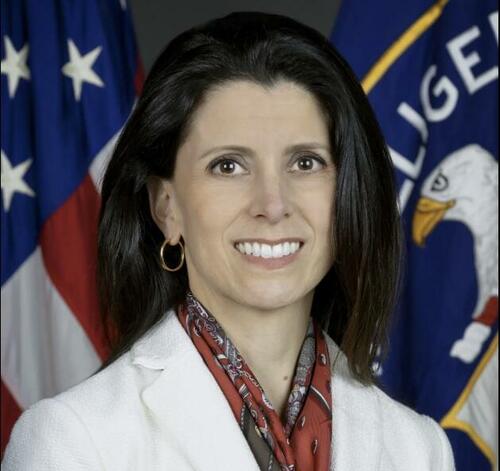 Via CIA/US gov website: Juliane Gallina Gloss was named the CIA’s deputy director for digital innovation in February 2024.
Via CIA/US gov website: Juliane Gallina Gloss was named the CIA’s deputy director for digital innovation in February 2024.
In a video, a thin young man with long hair tied in a messy bun carefully releases three tiny chicks from a box onto the grass. A tattoo of a peace sign — the emblem of the anti-war movement — is visible on his finger.
“We found some baby chicken in the [Turkish] local market and Itthobaal had the idea to get a few of them and maybe he will travel with them. He bought maybe three or four chickens and put them in a nice little box with straw and everything he could find. But the next one of the chickens died and the second one too. He was quite sad about it and felt very stupid that he had this dream of a whole journey together with this little new family.”
A year later, Itthobaal — one of the many names that 21-year-old American Michael Gloss used to introduce himself — signed a contract with the Russian Defense Ministry and died in Ukraine. IStories has reconstructed his final route.
This is the story about how a young anti-fascist, environmental activist and women’s rights advocate from the family of a CIA deputy director dreamed of traveling light around the world, but ended up in the Russian army.
Michael Gloss is one of more than 1,500 foreigners who passed through the Russian military recruitment center during the war in Ukraine, whose identities were established by IStories.
 IStories: Gloss put a photo taken at the regiment’s base on his avatar in his Odnoklassniki profile. Photo: Odnoklassniki
IStories: Gloss put a photo taken at the regiment’s base on his avatar in his Odnoklassniki profile. Photo: OdnoklassnikiRead the full detailed report here.
-
Site: Mises Institute
-
Site: Mises InstituteTom DiLorenzo, Tom Woods, and Robert Malone meet in Phoenix to expose how state power, psychological operations, and public health "experts" use bureaucracy as both a weapon and a weakness.
-
Site: Mises Institute62% think tariffs will be a net liability in the long run. Even more think it will be costly in the short run. They're right because tariff hikes are just tax increases on Americans.
-
Site: Mises Institute"Modern medicine looks more like a religion than a science—and its priests are bureaucrats."
-
Site: Mises Institute"In government, failure is success—and the worse you do, the more money you get."

